TANK GUNNERY PATCHES IN CONUS
U.S. Army units in the Continental United States ("CONUS") were generally slow to adopt qualification patches. There was one exception, however – the 5th Infantry Division(Mech) at Fort Carson, Colorado. The "5th Mech" was wearing a TCQC patch by 1967 and reportedly was wearing these patches as early as 1964. See Figure 1.
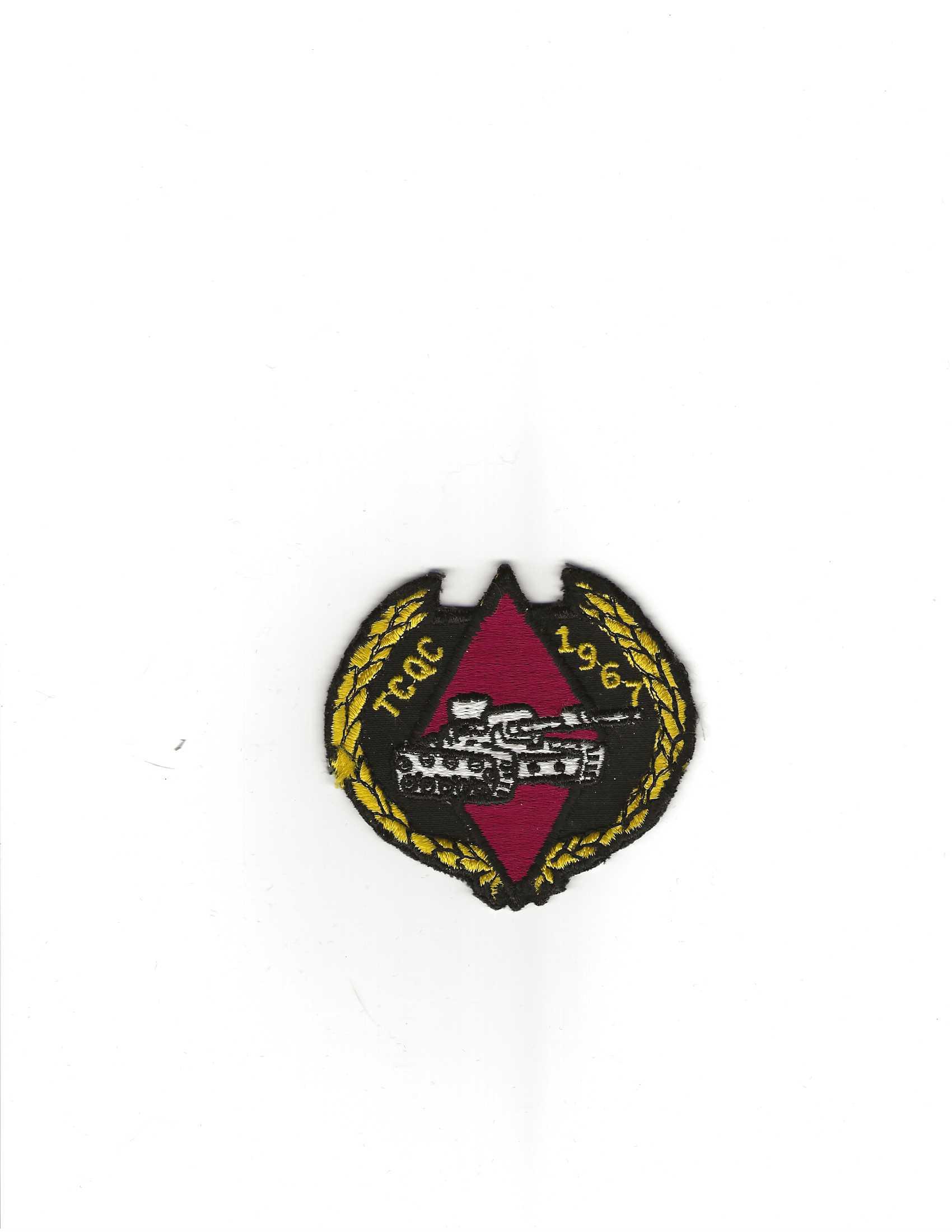
Figure 1
5th Infantry Division(Mech) 1967 TCQC Patch. U.S. made, embroidered on twill with a standard edge. ASMIC #5C.
In 1970 the 5th Infantry Division(Mech) was reflagged as the 4th Infantry Division(Mech) as part of the drawdown of the Army following the Vietnam War.
4th Infantry Division(Mech)
By 1972 the 4th Infantry Division(Mech) was wearing TCQC patches. That year its patch was based on the Division shoulder patch, with Armor branch insignia and "TCQC" added. When worn by the 2nd Bn, 34th Armor a tab was added that identified the Battalion. I do not know if the Division's other Armor Battalions wore such tabs.
The Division then adopted a different TCQC design during the period 1973–75. The distinguished version of the 1973 patch has an attached tab that reads "Distinguished 1973," whereas the 1974 and 1975 patches have a separate tab. See, e.g., Figure 2.
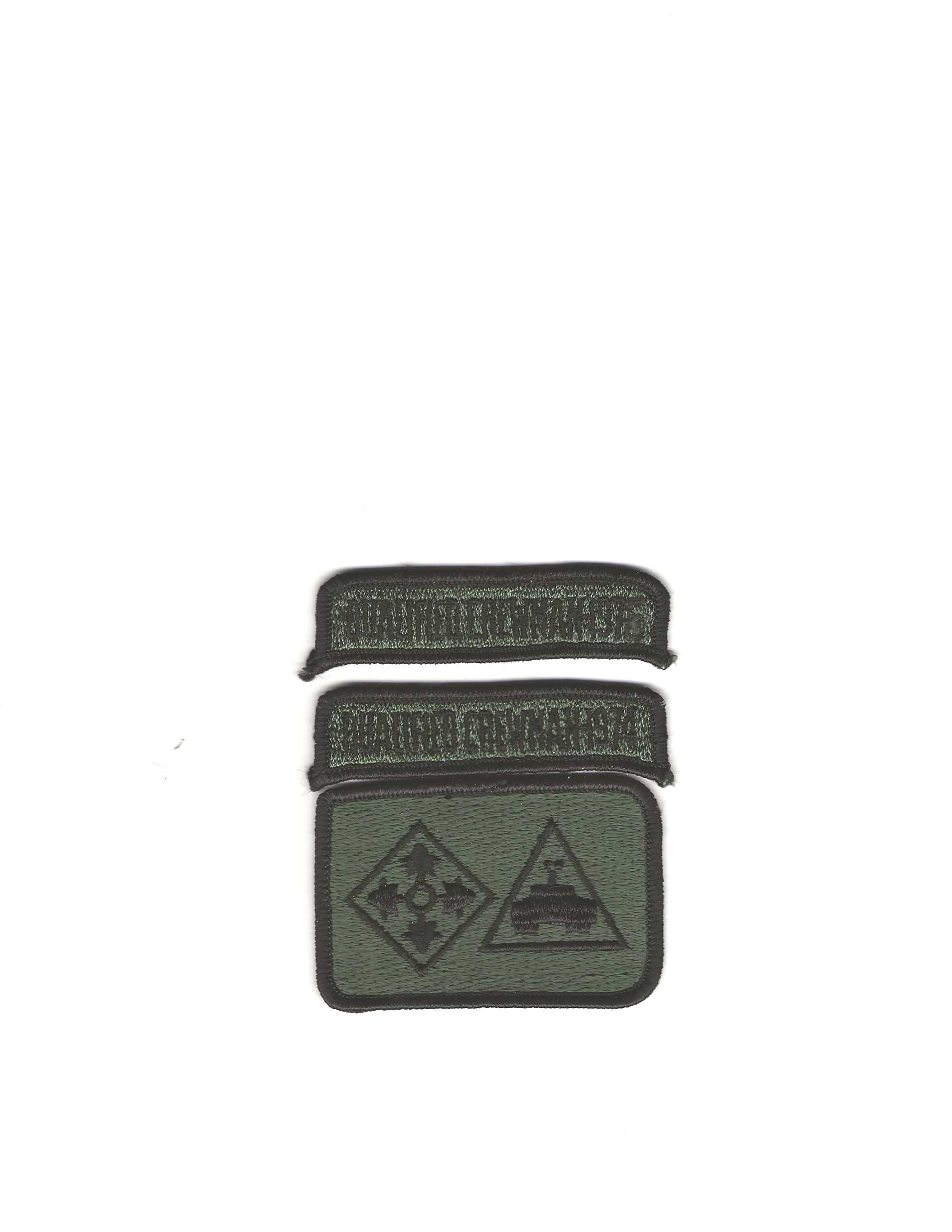
Figure 2
4th Infantry Division(Mech) TCQC patch with 1974 and 1975 "Qualified Crewman" tabs. U.S. made, all embroidered with a merrowed edge. ASMIC #4Q, 4Q2, and 4Q3.
However, in 1974 a new design appeared that the 4th Infantry Division(Mech) apparently used through 1981 (with a slightly different design issued in 1982). This patch featured a unique type of construction – black felt fused to thin twill olive drab cloth. Another unusual thing about this patch was that it was only manufactured as a Distinguished patch. For soldiers who only achieved a Qualified rating, the "Distinguished" tab was cut off the patch with a pair of scissors before the soldier sewed the patch onto his uniform. As far as I am aware, the 4th Infantry Div(Mech) and a National Gaurd unit, the 1st Sqdn, 194th Cavalry(See Reserve Component Units article, Figure 9) were the only units that used this approach. See, e.g., Figure 3.
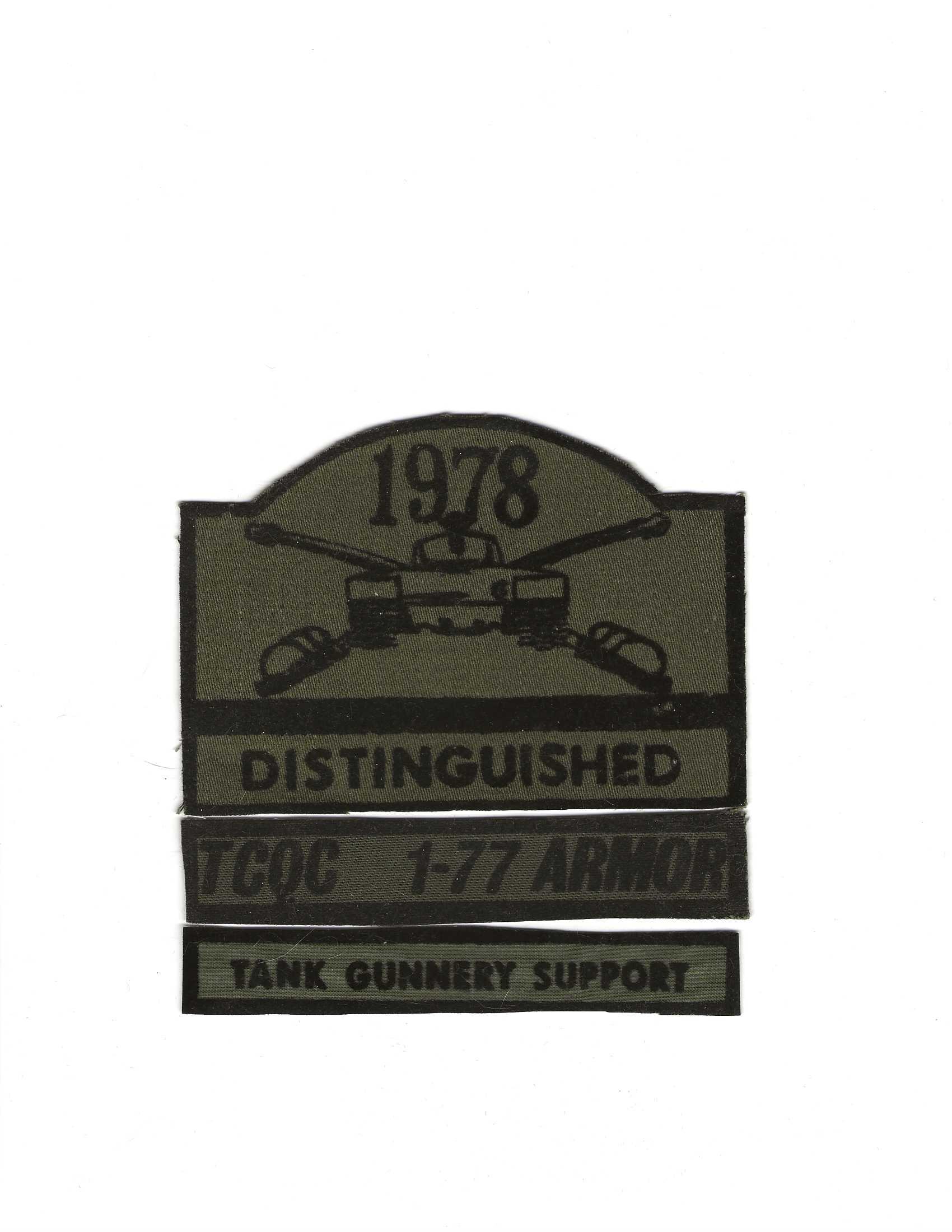
Figure 3
4th Infantry Division(Mech) 1978 Distinguished TCQC patch (ASMIC #77A10) with "TCQC 1–77 Armor" (ASMIC #77A8) and "Tank Gunnery Support" (not in ASMIC catalog) tabs. U.S. made, felt(?) on twill.
I have not seen tabs for any of the 4th Inf Div(M)'s tank battalions other than the 1st Bn, 77th Armor. I do not know if the "Tank Gunnery Support" tab was worn by the other tank battalions in 4th Inf Div(M). The ASMIC TCQC catalog erroneously identifies this patch for the 1–77 Armor, when it was actually issued by HQ, 4th ID(M). It is unclear why there are two different 4th Infantry Division(Mech) TCQC patches for 1974 and 1975.
In addition, the 1st Bn, 77th Armor issued its own TCQC patch at some point. See Figure 4.
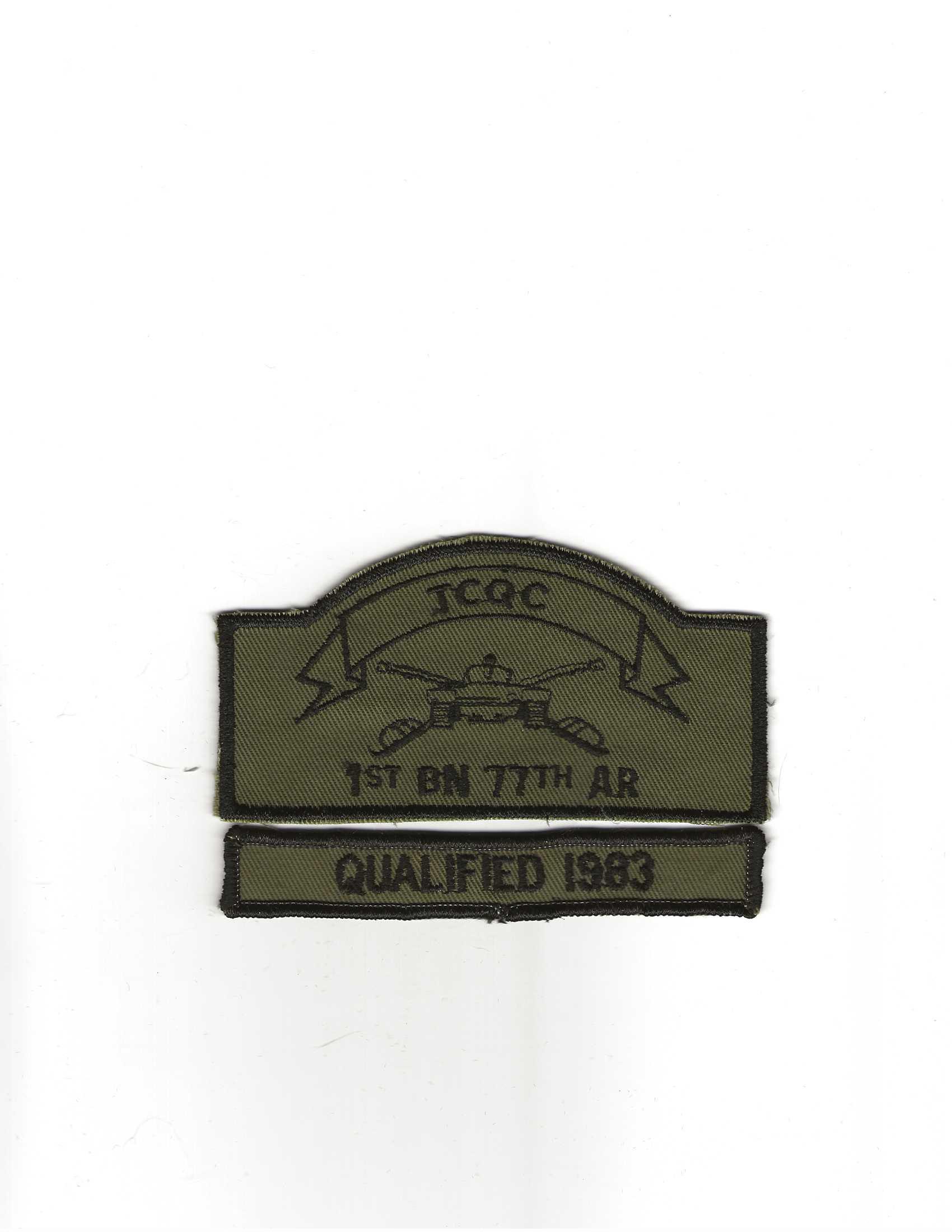
Figure 4
1st Bn, 77th Armor TCQC patch (ASMIC #77D) with "Qualified 1983" tab (not in ASMIC catalog) (4th Inf Div(M)). U.S. made, embroidered on twill. The patch has a standard edge whereas the tab has a merrowed edge. I am not certain that this tab was worn with this patch.
The 4th Infantry Division(Mech)'s cavalry squadron, the 1st Sqdn, 10th Cavalry, issued qualification patches in 1975 and 1976. See, e.g., Figure 5.
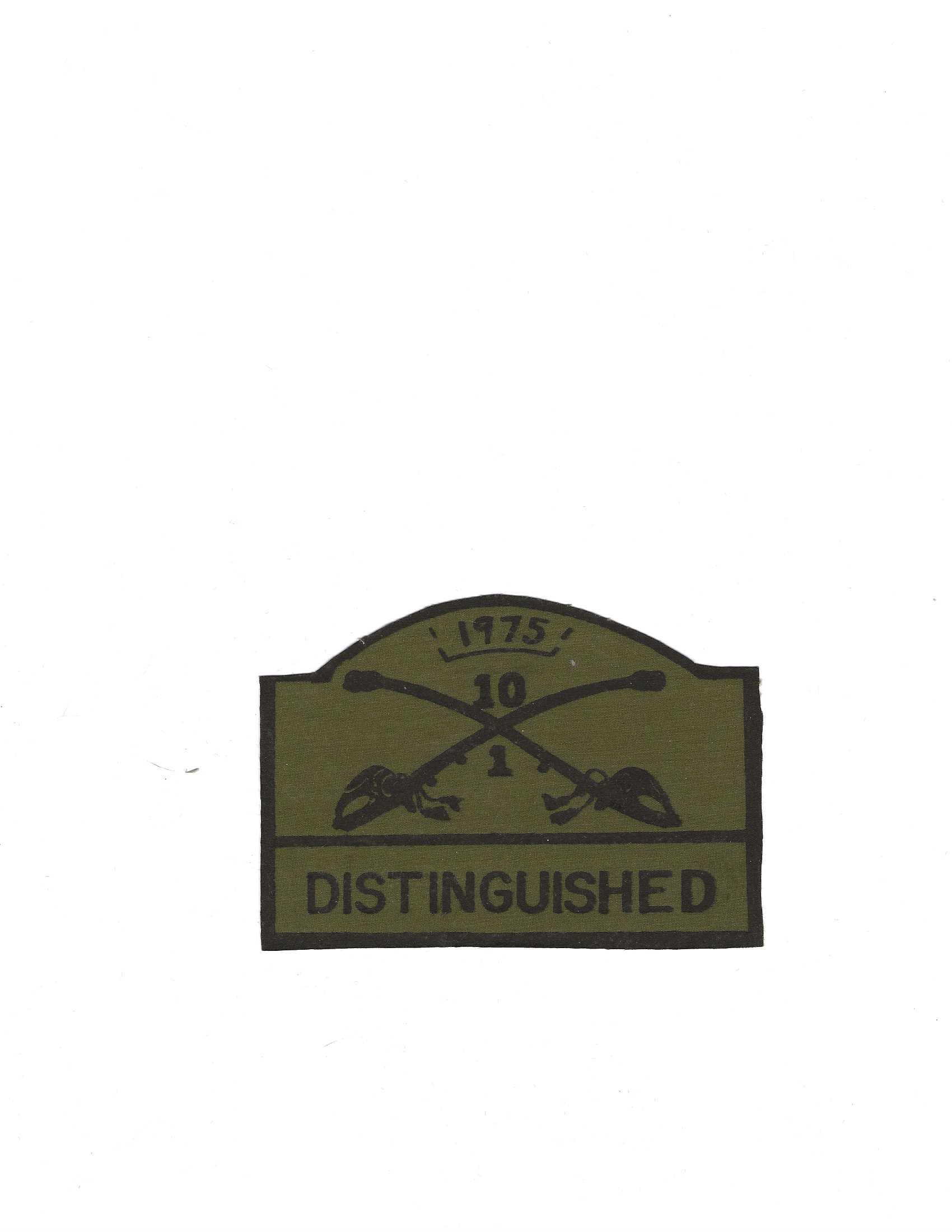
Figure 5
1st Sqdn, 10th Cavalry 1975 Distinguished qualification patch (4th Inf Div(M)). It is unclear which vehicle crews were issued this patch. U.S. made, printed on a very thin material (if you hold it up to a light you can see through it). ASMIC #10A6. This patch was only manufactured in this "Distinguished" version; for soldiers who only achieved a "Qualified" rating, the "Distinguished" tab was cut off the patch with a pair of scissors.
Beginning in 1976, the 4th ID issued a similar division-level patch for scout vehicle crews. This same basic patch was worn through at least 1978. These patches were presumably worn by the 1st Squadron, 10th Cavalry, and the scout platoons assigned to the Division's tank and mechanized infantry battalions.
The 4th Infantry Division(Mech) also issued qualification patches to Redeye teams and Ground Surveillance Radar crews at some point, probably in the late 1970s. See, e.g., Figure 6.
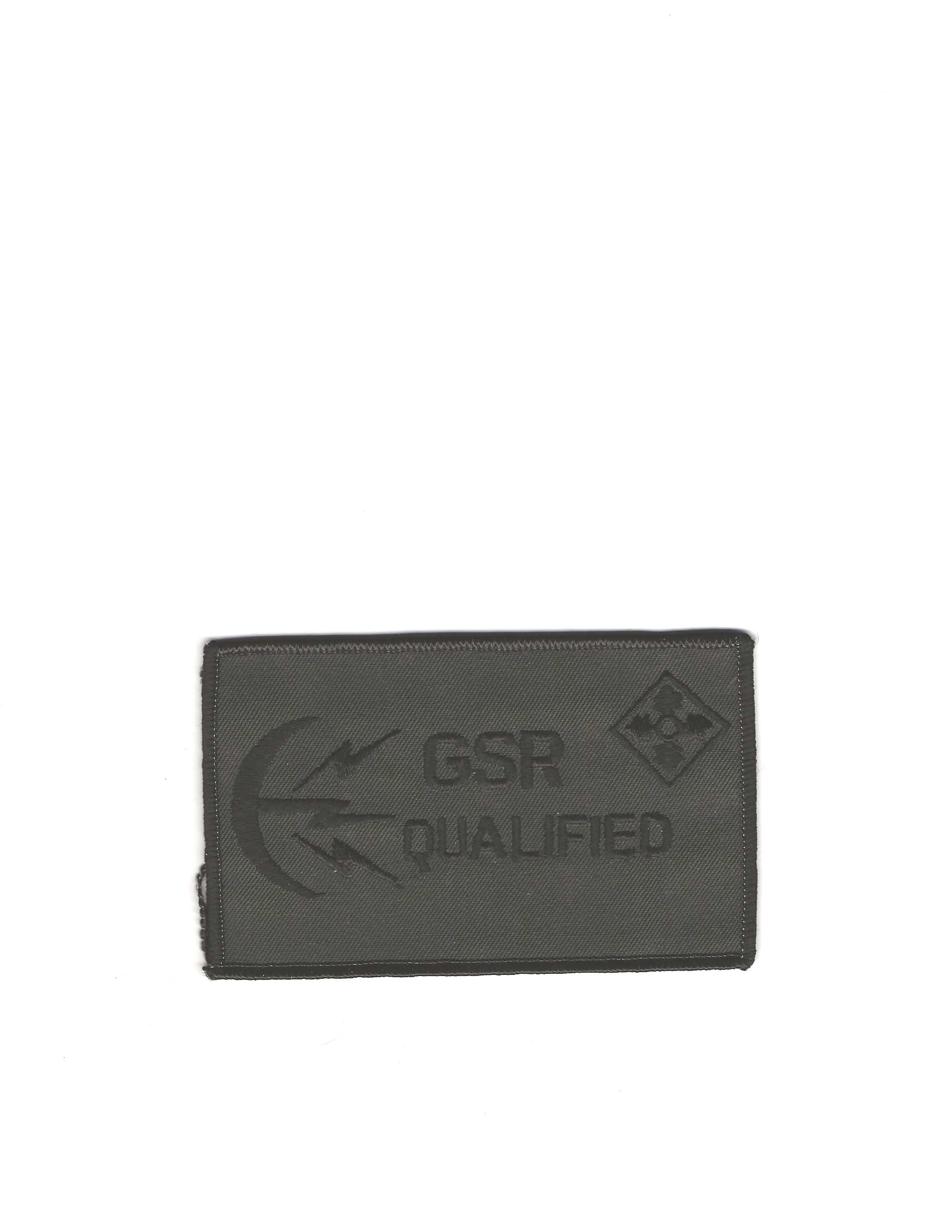
Figure 6
4th Infantry Division(Mech) Qualified Ground Surveillance Radar ("GSR") patch. U.S. made, embroidered on twill with a merrowed edge. ASMIC #4D. It is unclear when this patch was worn and whether it was worn with tabs that stated the year awarded.
Unlike most U.S. Army units, which discontinued using qualification patches around 1983, the 4th ID issued TCQC patches in at least 1984, 1986, and 1987. See, e.g., Figure 7.
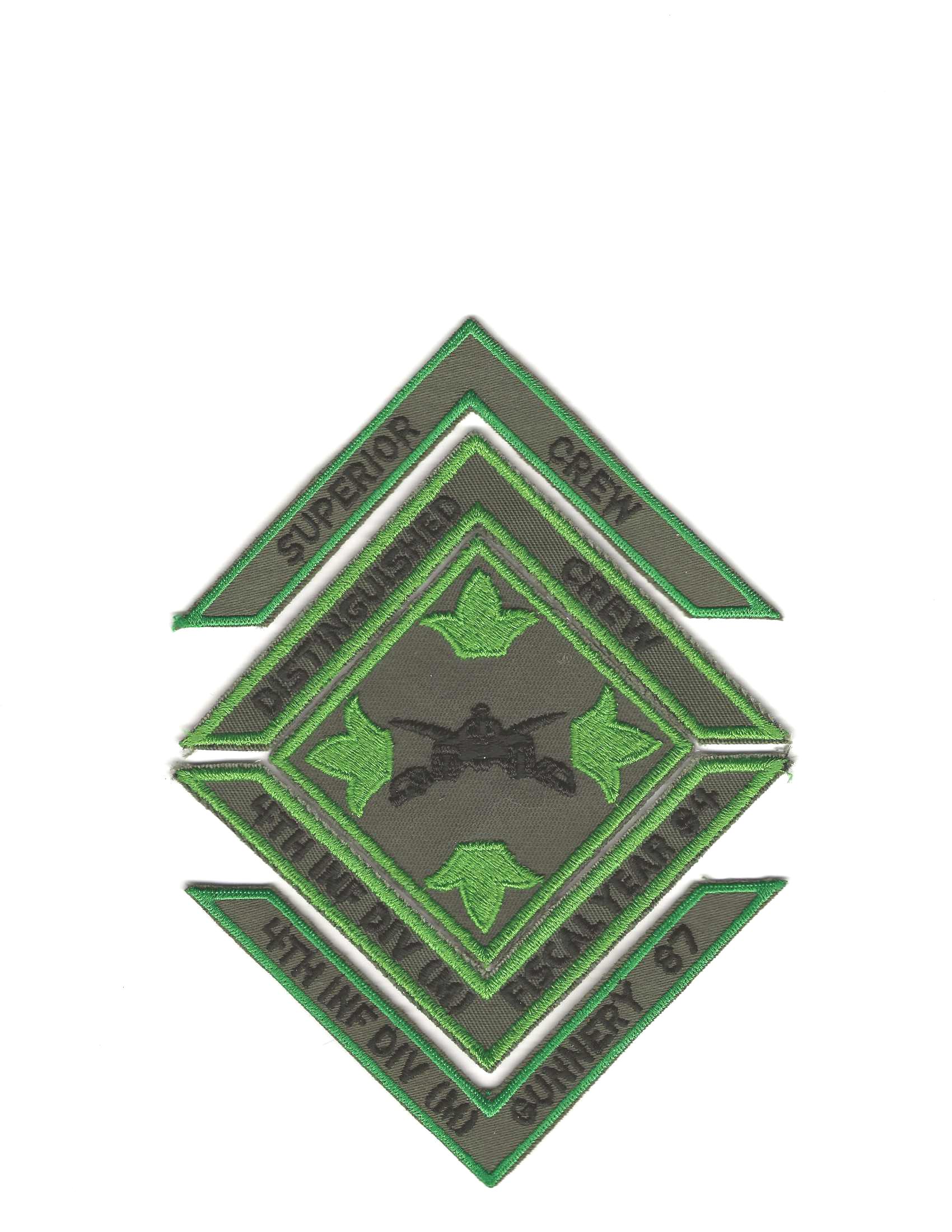
Figure 7
4th Infantry Division(Mech) TCQC patch (ASMIC #4C), with "Superior Crew" (ASMIC #4C2), "Distinguished Crew" (not in ASMIC catalog), "4th Inf Div(M) Fiscal Year 84" (not in ASMIC catalog), and "4th Inf Div(M) Gunnery 87" (ASMIC #4C4) tabs. U.S. made, embroidered on twill with a standard edge.
In addition, it appears the 3rd Brigade, 4th Infantry Division(Mech) issued qualification patches to its scouts, tank crews, and mortar crews while the Brigade was stationed at Fort Carson during the late 1990s.
Fort Hood, Texas
The Army's biggest concentration of armored units was at Fort Hood, Texas. During the 1960s through the 1980s there were two armored divisions stationed at Fort Hood, along with III Corps headquarters and supporting units.
Fort Hood is unique in that both of the divisions there used the same basic design for their gunnery patches and issued the same array of patches: TCQC, mechanized infantry squad, howitzer section, air defense artillery, and an enigmatic patch that featured crossed sabers and Army aviator wings. This suggests it was issued to scout helicopter crews, and possibly other helicopter crews within air cavalry units. See, e.g., Figures 9-11 (Figure 8 has been deleted).
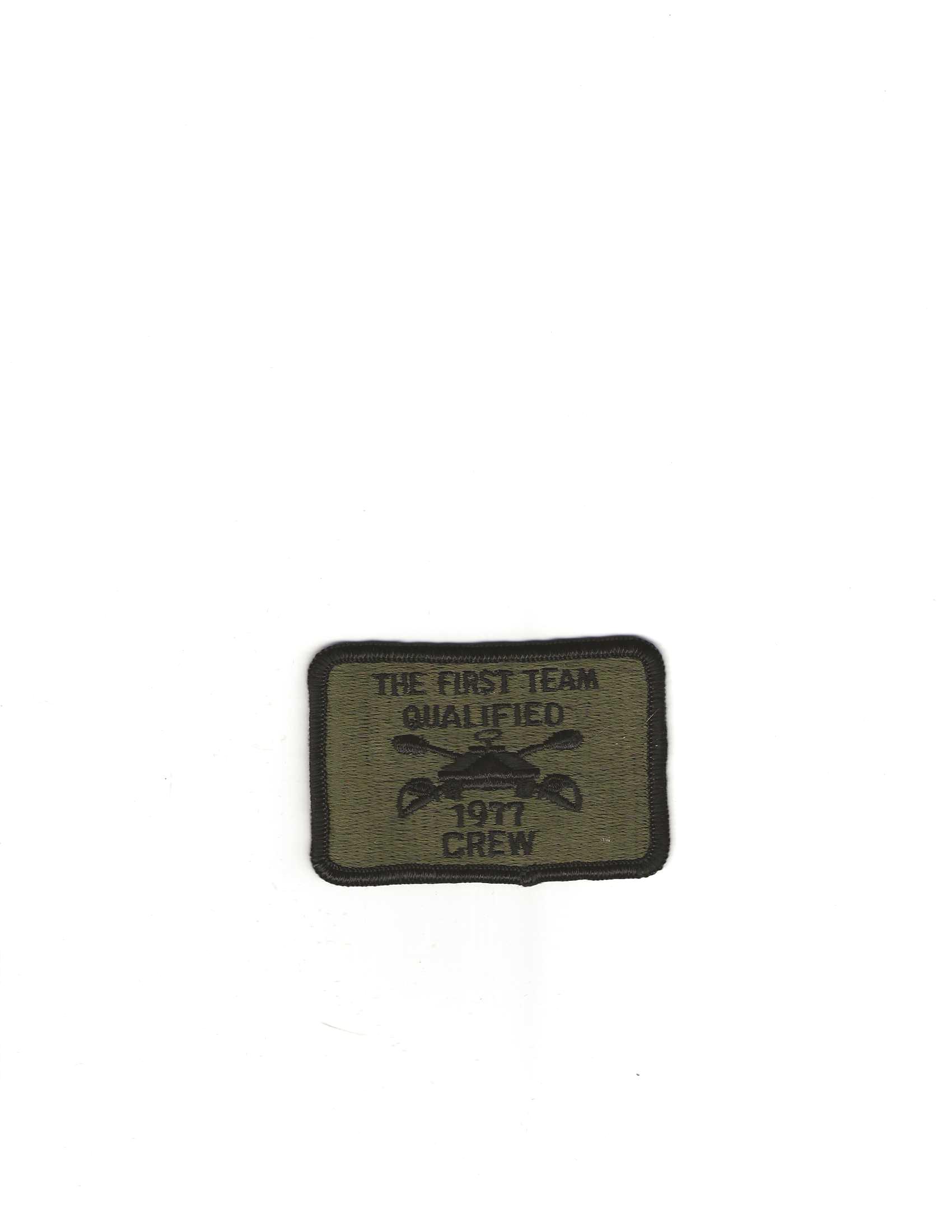
Figure 9
1st Cavalry Division 1977 Qualified TCQC patch. U.S. made, all embroidered with a merrowed edge. ASMIC #1T1.
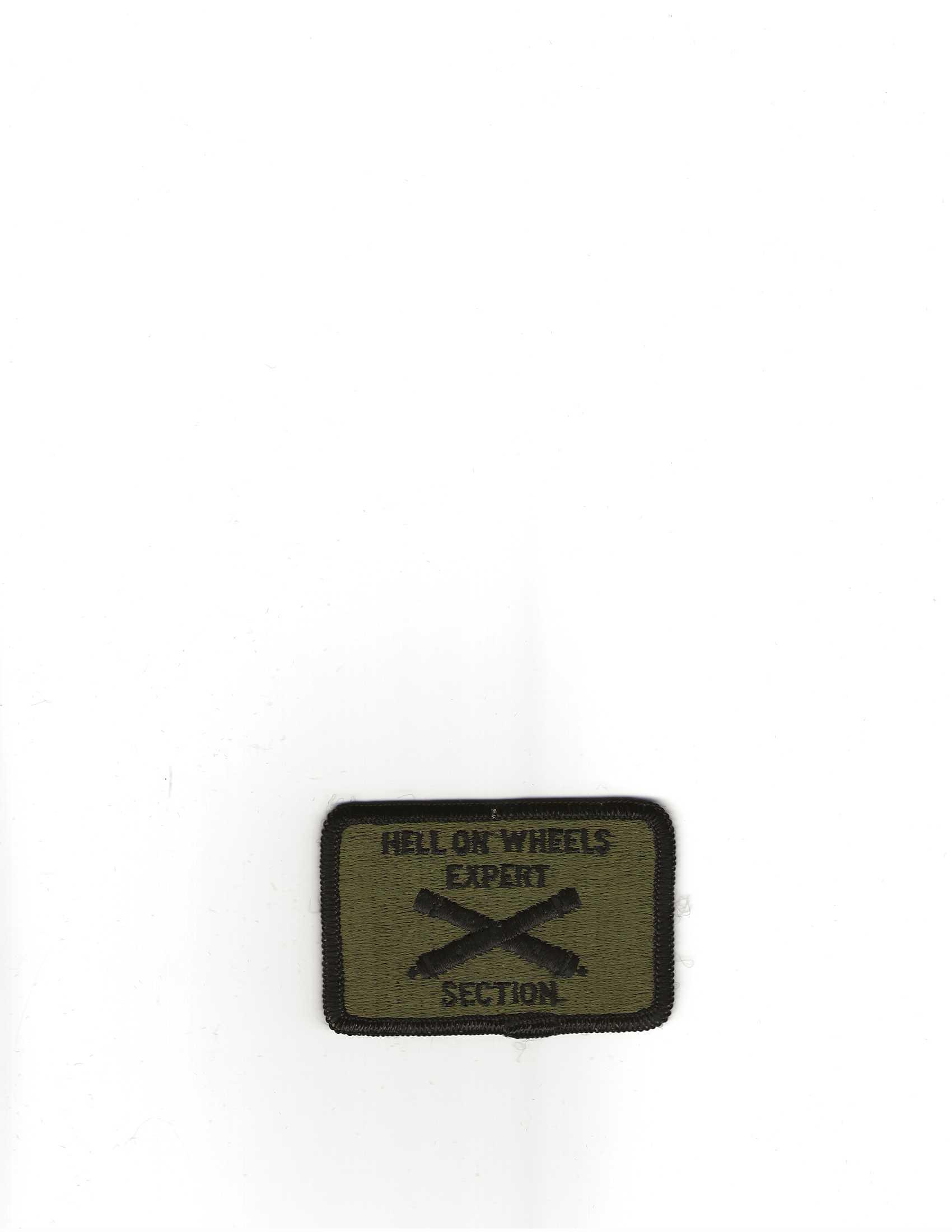
Figure 10
2nd Armored Division Expert Field Artillery Howitzer Section patch. U.S. made, all embroidered with a merrowed edge. ASMIC #2F.
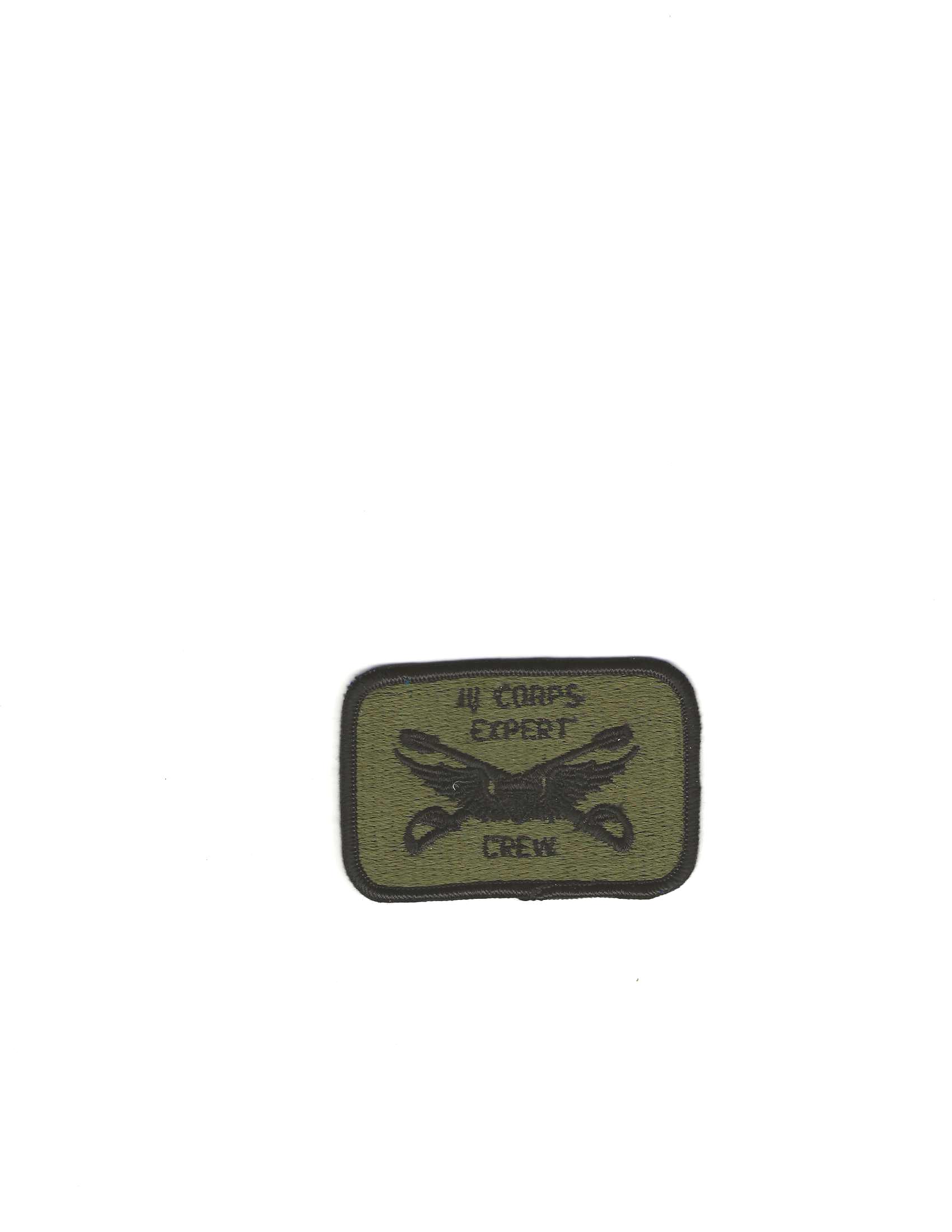
Figure 11
III Corps Expert Helicopter crew (?) patch. U.S. made, all embroidered with a merrowed edge. ASMIC #3A. It is unclear which unit wore this patch, and which personnel were eligible to wear it. The patch includes cavalry crossed sabers and aviator's wings, so it was presumably issued to personnel flying OH-58 "Kiowa" scout helicopters. The III Corps had one such unit in the mid-1970s through mid-1990s: 6th Cavalry Brigade(Air Combat), which was stationed at Fort Hood. It is possible that other personnel also wore this patch, e.g., attack helicopter crewmen.
Another unusual thing about these patches is that, with the exception of the TCQC patches, they only exist in "Expert" versions. By contrast, the 1st Cavalry Division issued TCQC patches in "Qualified," "Expert," and "Distinguished" versions, and the 2nd Armored Division issued TCQC patches in "Qualified," "Superior," "Expert," and "Distinguished" versions. As far as I am aware, the 2nd Armored Division was the only unit that issued four levels of TCQC patches. I do not know the hierarchy of these patches but if I had to guess, it would be: Qualified, Superior, Expert, Distinguished.
It appears these patches were first worn in 1976 or 1977, and were in use through the late 1970s or early 1980s. Most of these patches did not have the year on them and it does not appear that there were tabs issued that stated the year. However, some 1st Cavalry Division TCQC patches included "1977" or "1978." See, e.g., Figure 9(above).
There were only a handful of battalions at Fort Hood that issued their own gunnery patches. In the 1st Cavalry Division: (1) the 1st Bn, 81st Armor wore TCQC patches in 1974, see Figure 12; (2) the 1st Bn, 7th Cavalry issued "Distinguished" TCQC patches in 1975, see Figure 13, and "Superior" TCQC patches in 1978; and (3) the 1st Sqdn, 9th Cavalry issued M551 Sheridan TCQC patches, apparently in the mid or late 1970s. See Main Article, Figure 9.
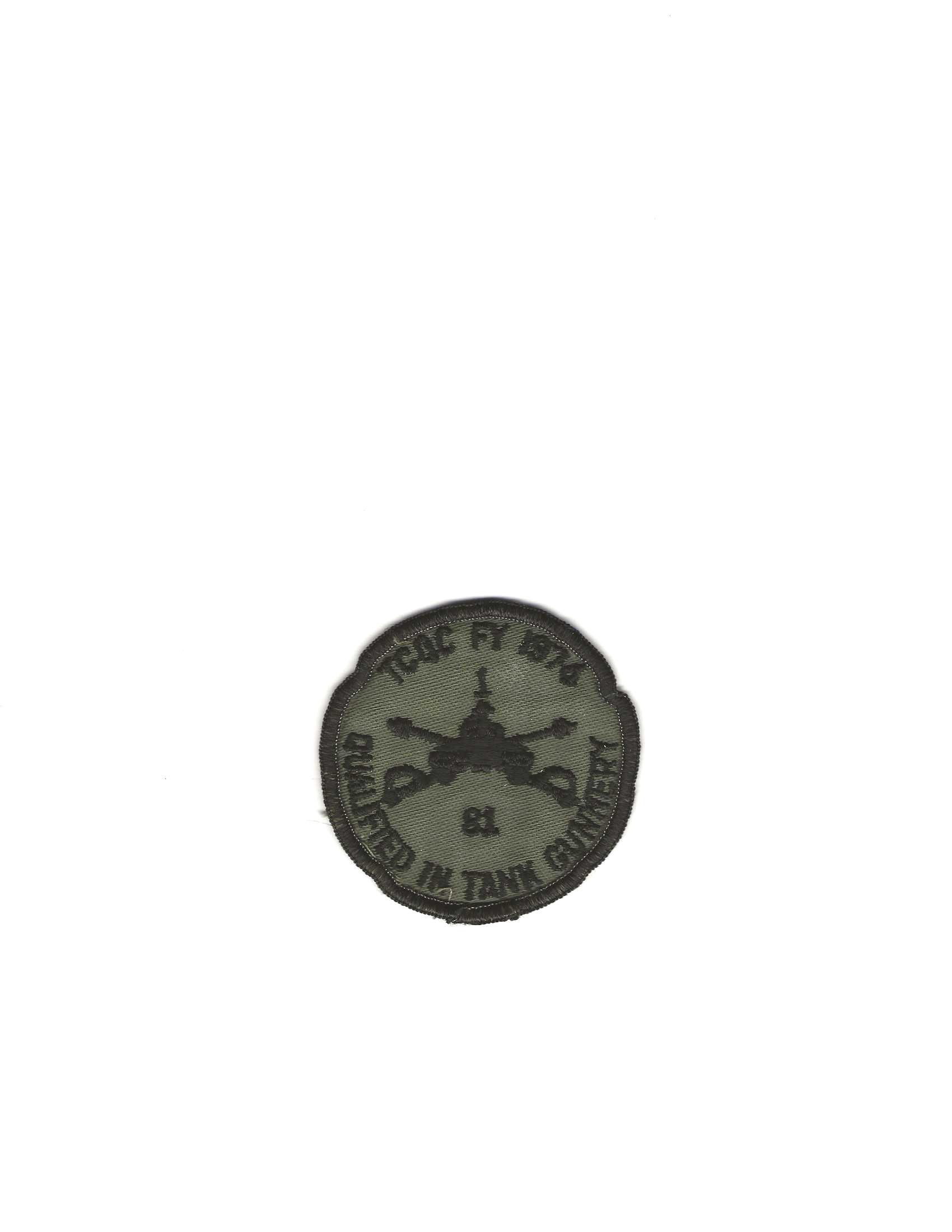
Figure 12
1st Bn, 81st Armor 1974 Qualified TCQC patch (1st Cav Div). U.S. made, embroidered on twill with a merrowed edge. Not in ASMIC catalog. I do not know if there were other versions of this patch, such as "Distinguished" or "Support."

Figure 13
1st Bn(Armor), 7th Cavalry 1975 Distinguished TCQC patch (1st Cav Div). U.S. made, all embroidered with a merrowed edge. ASMIC #7C6. I do not know if there were other versions of this patch, such as "Qualified" or "Support."
In addition, the 1st Bn, 13th Armor purchased 1972 TCQC patches, but supposedly these patches were never worn because a new battalion commander prohibited their use. See Figure 14.
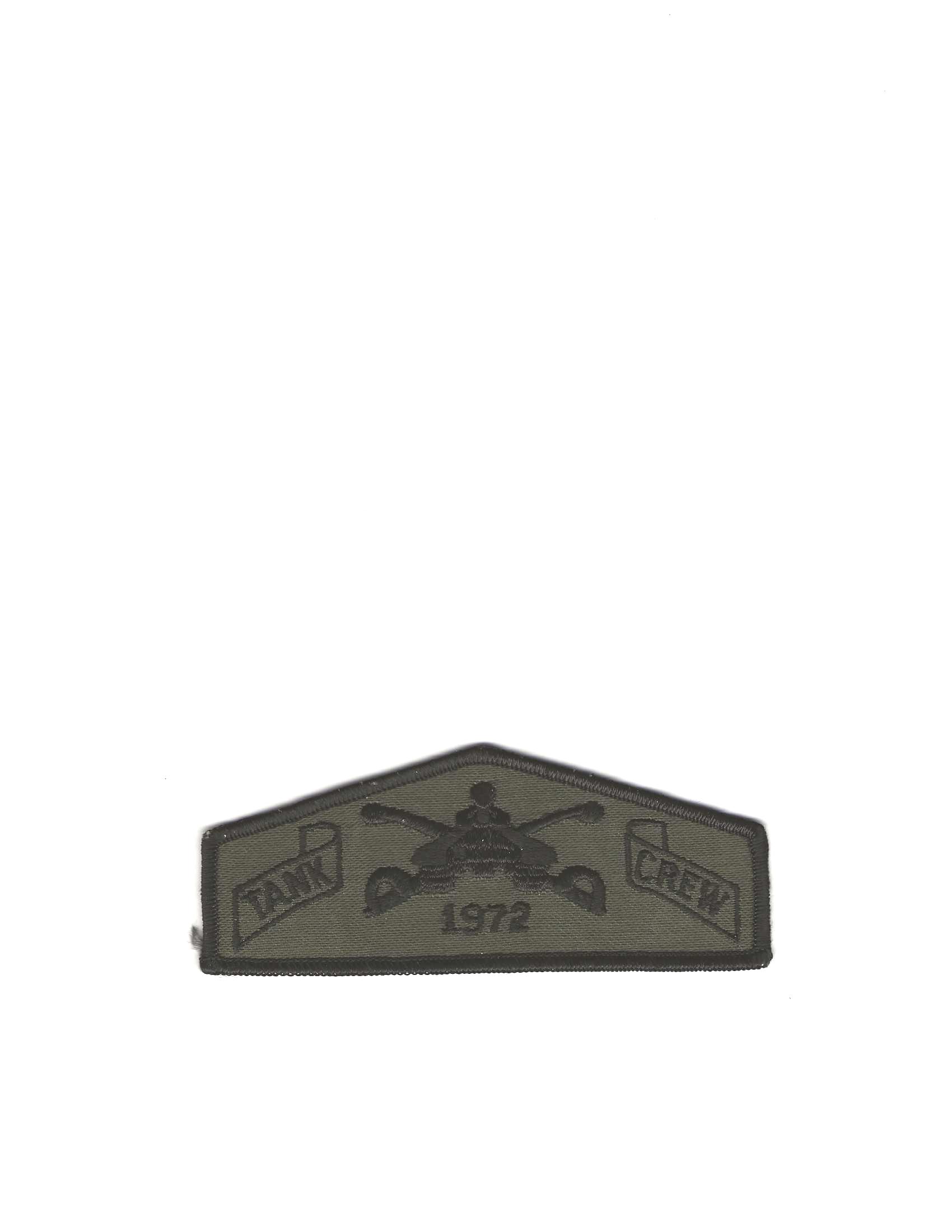
Figure 14
1st Bn, 13th Armor 1972 TCQC patch (1st Cav Div.) U.S. made, embroidered on twill with a merrowed edge. ASMIC #13D.
In the 2nd Armored Division, the 1st Bn, 67th Armor issued qualification patches to drivers of their M520 "Goer" 8-ton cargo trucks. See Figure 15.
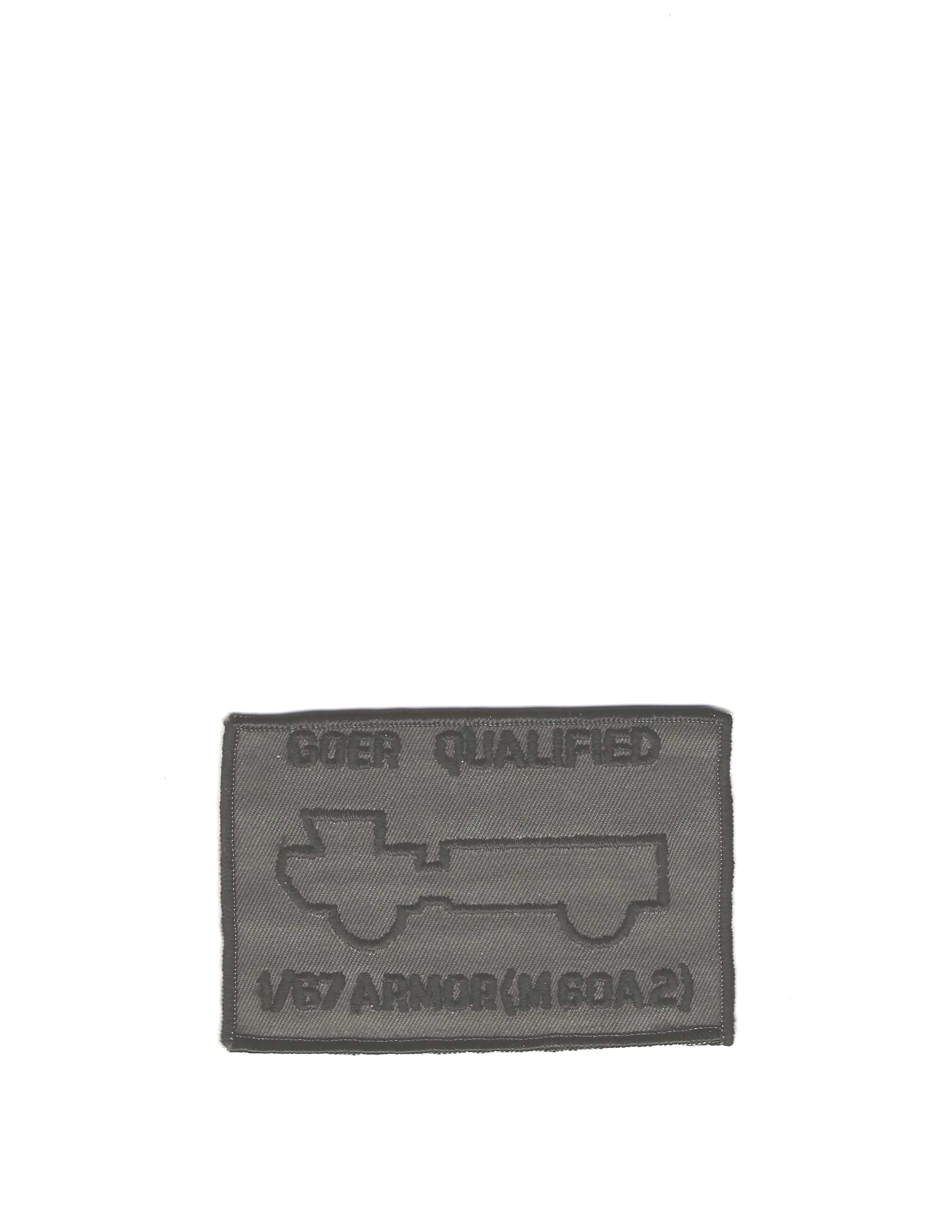
Figure 15
1st Bn, 67th Armor Qualified "Goer" patch (2nd Armd Div). U.S. made, embroidered on twill with a merrowed edge. ASMIC #67C. It is unclear if this patch was issued in a "Distinguished" version (or if a "Distinguished" tab was issued with this patch). It is also unclear when this patch was worn.
As discussed above, this unit also apparently issued a TCQC patch in 1973. See Figure 8 (above).
Fort Knox, Kentucky
Fort Knox, Kentucky, was the home of Armor branch until 2011, when the Armor School moved to Fort Benning. There are surprisingly few gunnery patches that are known to have been worn at Fort Knox.
During the Cold War the 194th Armored Brigade was stationed at Fort Knox. There were two armor battalions, an armored cavalry troop, and an air cavalry unit (initially a squadron, later a troop) assigned to the 194th, along with a mechanized infantry battalion, field artillery battalion, and other units.
The 5th Bn, 33rd Armor issued TCQC patches in 1976 that had the year on the patch. See Marque (patches at the top of this website's homepage). There are also qualification patches from this unit that lack the year and may have been issued in other years, probably with a tab that stated the year and level of qualification. See, e.g., Figure 16.
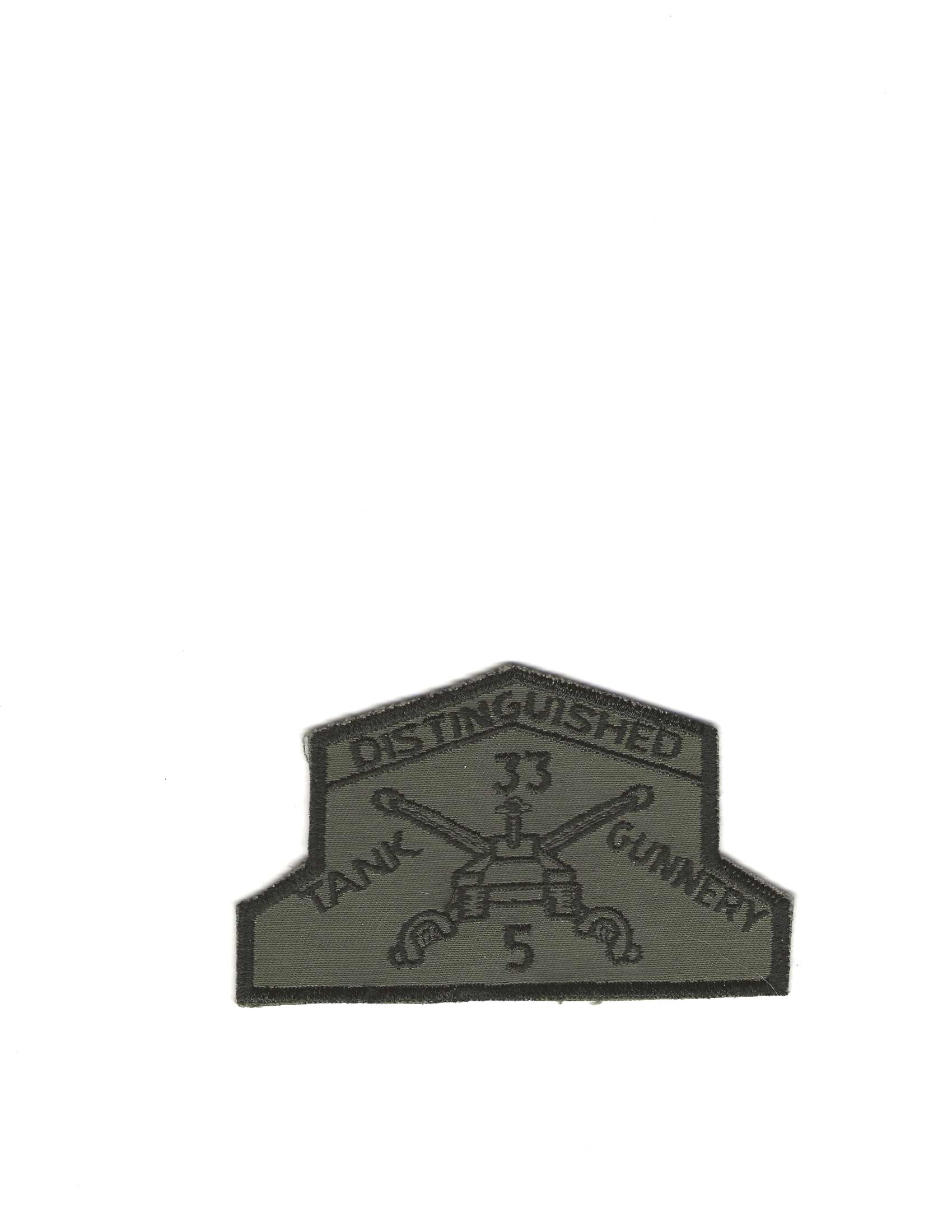
Figure 16
5th Bn, 33rd Armor Distinguished TCQC patch (194th Armd Bde). Embroidered on twill, with a standard edge. Not in ASMIC catalog. This patch was also issued in a "Qualified" version.
See Marque (patches at top) on this website's homepage for another patch issued by this unit.
The 4th Bn, 37th Armor issued qualification patches in at least 1977. See, e.g., Figure 17.
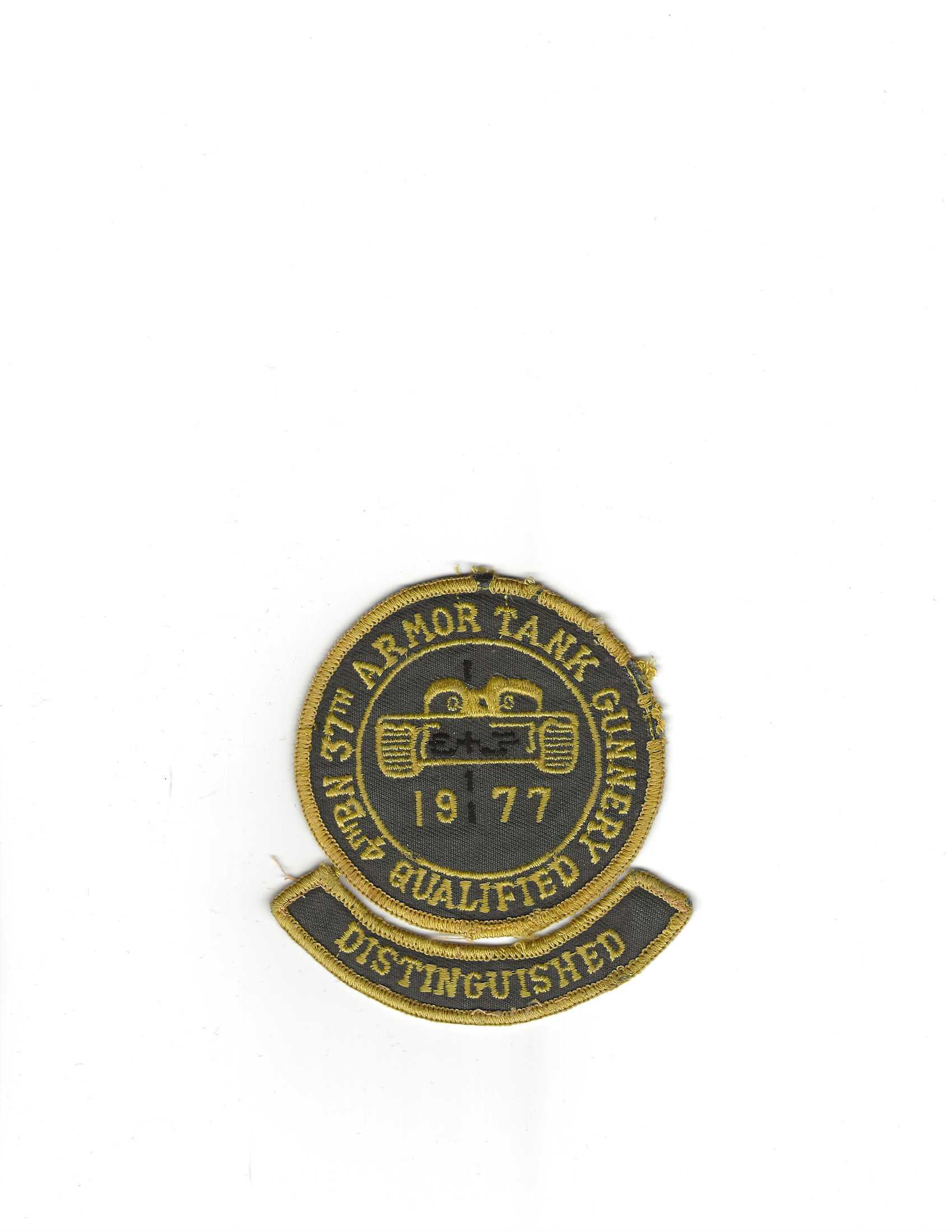
Figure 17
4th Bn, 37th Armor 1977 Qualified TCQC patch (ASMIC #37F) with "Distinguished" tab (not in ASMIC catalog) (194th Armd Bde). U.S. made, embroidered on twill with a merrowed edge.
The 4–37 Armor also issued a "Support" patch in 1977.See Marque (patches at top) on this website's homepage.
Finally, the 2nd Sqdn, 6th Cavalry was stationed at Fort Knox and supported the Armor School. Troop G issued a qualification patch in 1977. See Figure 18.
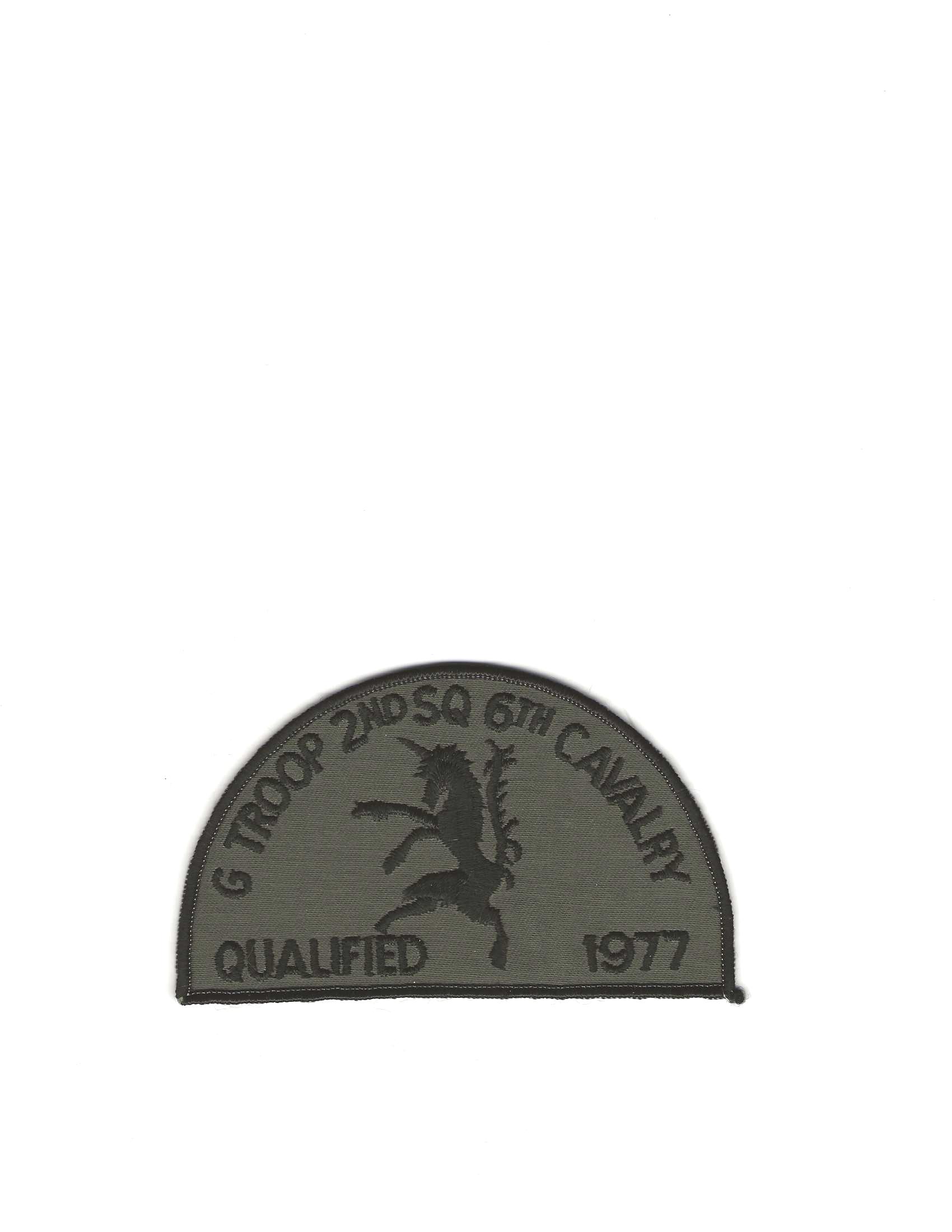
Figure 18
Troop G, 2nd Sqdn, 6th Cavalry 1977 Qualified patch. U.S. made, embroidered on twill with a merrowed edge. ASMIC #6G. It is unclear which vehicle crews were eligible to wear this patch. It is also unclear if this patch was issued in a "Distinguished" version (or if a "Distinguished" tab was issued with this patch).
This is a rare patch that was issued by a troop that was assigned to a squadron.
As far as I am aware, none of the training units at Fort Knox that trained tankers and scouts issued qualification patches to their trainee vehicle crews.
<>3rd Armored Cavalry Regiment
The 3rd Armored Cavalry Regiment moved to Fort Lewis, Washington, from West Germany in 1968. Four years later it was transferred to Fort Bliss, Texas, where the Regiment remained until 1996. Regimental Headquarters issued TCQC patches in at least 1969, 1970, 1971, 1973, and 1974. See, e.g., Figure 19.
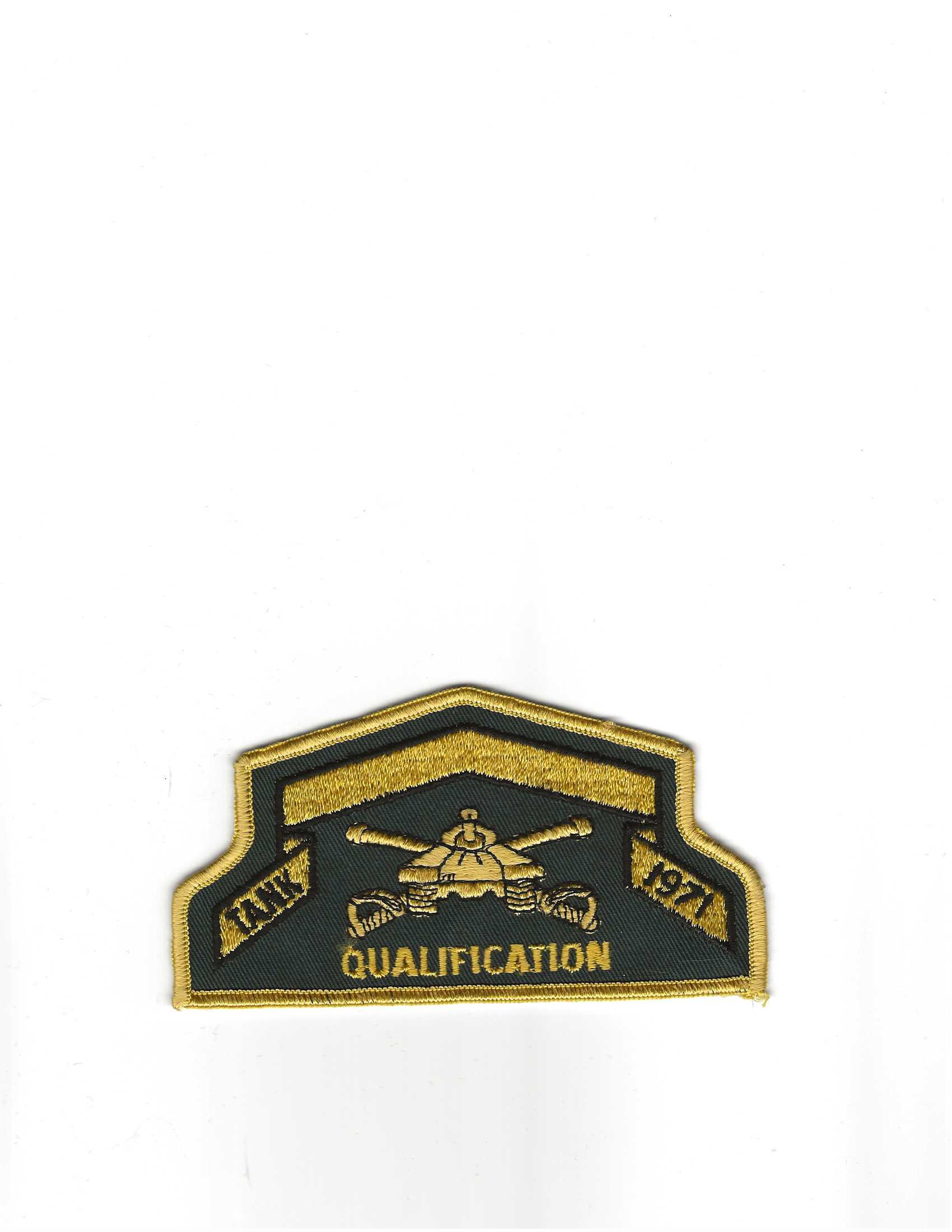
Figure 19
3rd Armored Cavalry Regiment 1971 Qualified TCQC patch. U.S. made, embroidered on twill with a merrowed edge. ASMIC #3B1. It is unclear if this patch was issued in an, e.g., "Distinguished" version. There is, however, a subdued "Distinguished" version of this patch (erroneously identified as ASMIC #3A in THE TRADING POST (Oct-Dec 1992), p. 42).
It does not appear any qualification patches were worn in the 3rd Cav in 1975. Beginning in 1976, each squadron issued its own patches, a practice that continued through approximately 1983. See, e.g., Figures 20–22.
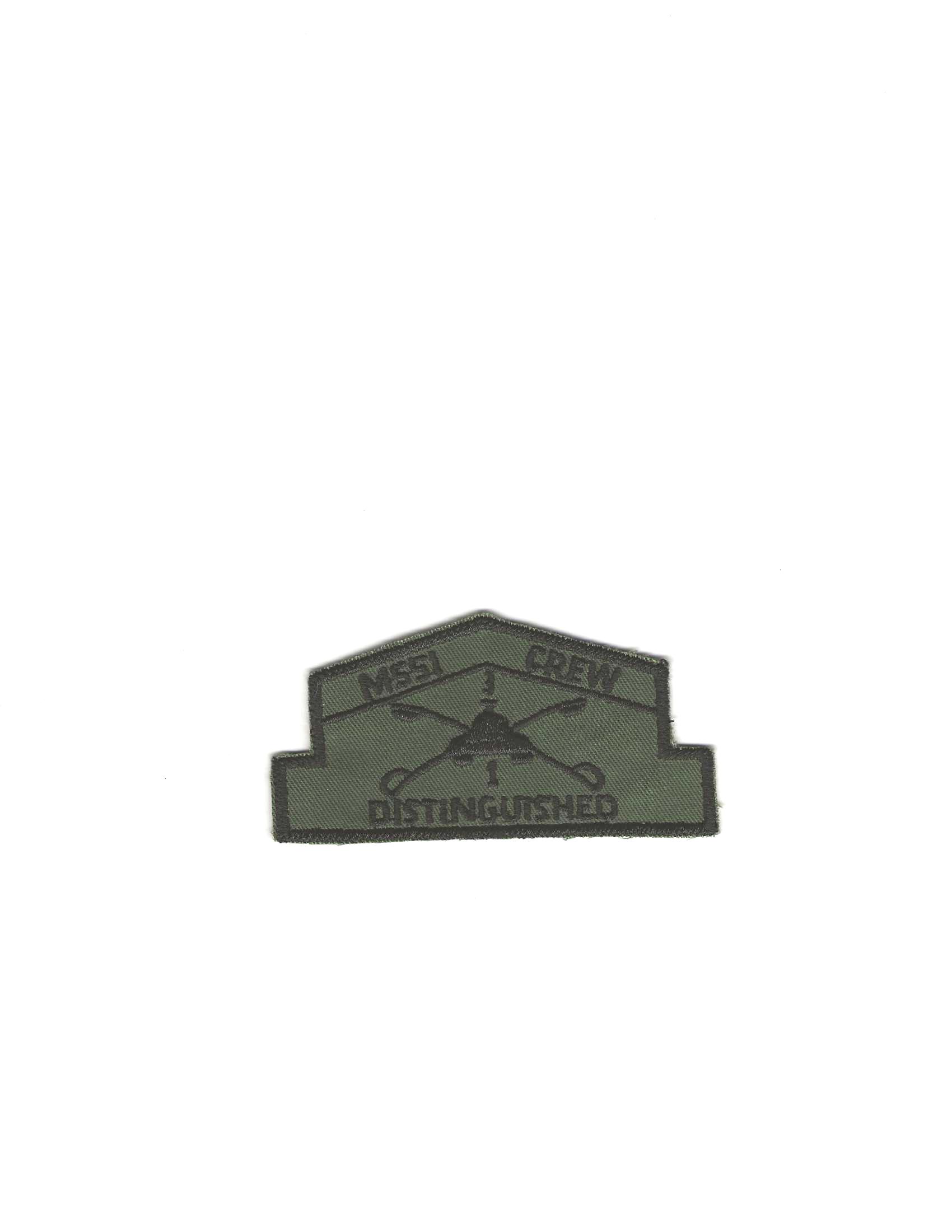
Figure 20
1st Sqdn, 3rd Armored Cavalry Regiment 1976 Distinguished M551 TCQC patch. U.S. made, embroidered on twill with a standard edge. ASMIC #3C19.
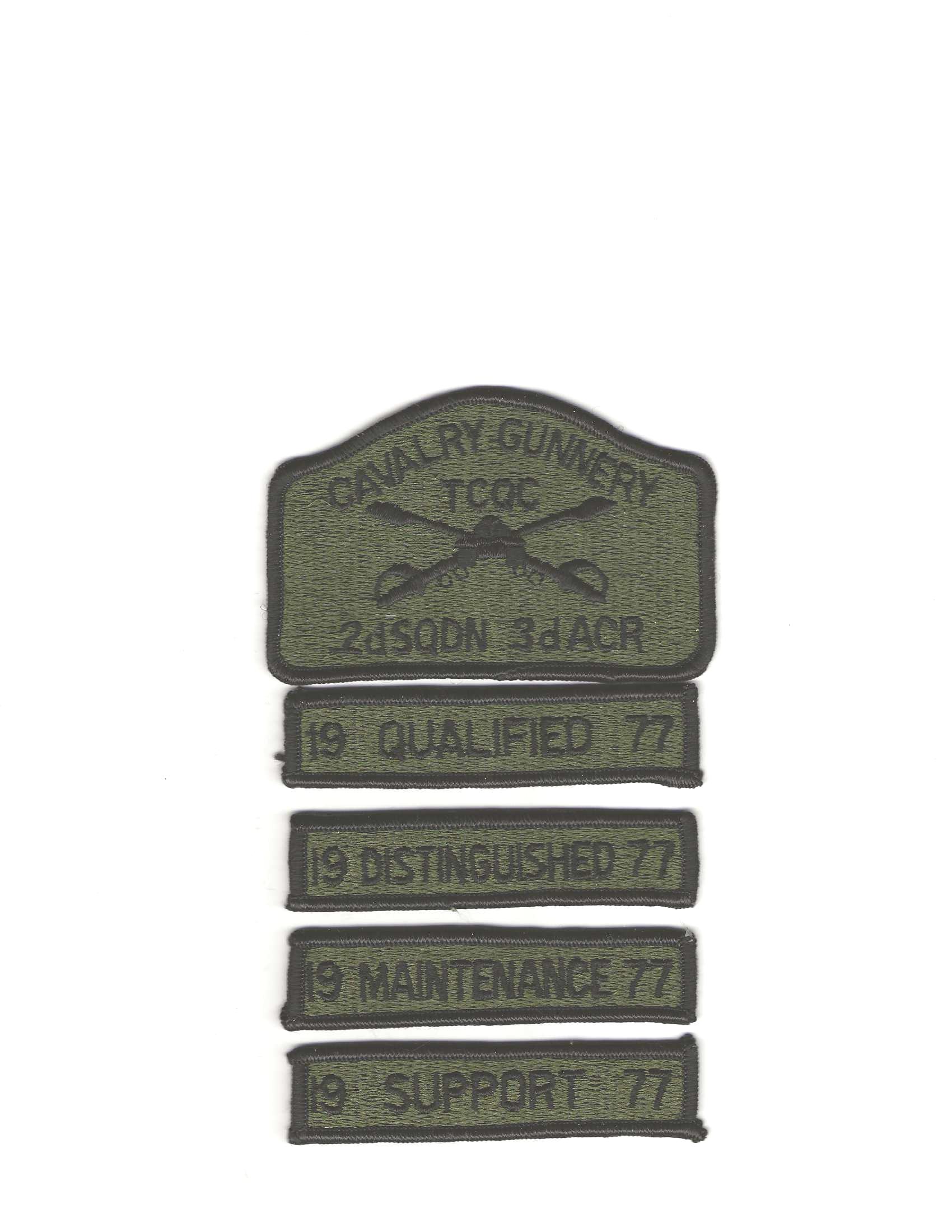
Figure 21
2nd Sqdn, 3rd Armored Cavalry Regiment TCQC patch with "19 Qualified 77," "19 Distinguished 77," "19 Maintenance 77," and "19 Support 77" tabs. U.S. made, all embroidered with a merrowed edge. ASMIC #3D13, 3D14, 3D15, 3D16 & 3D17.
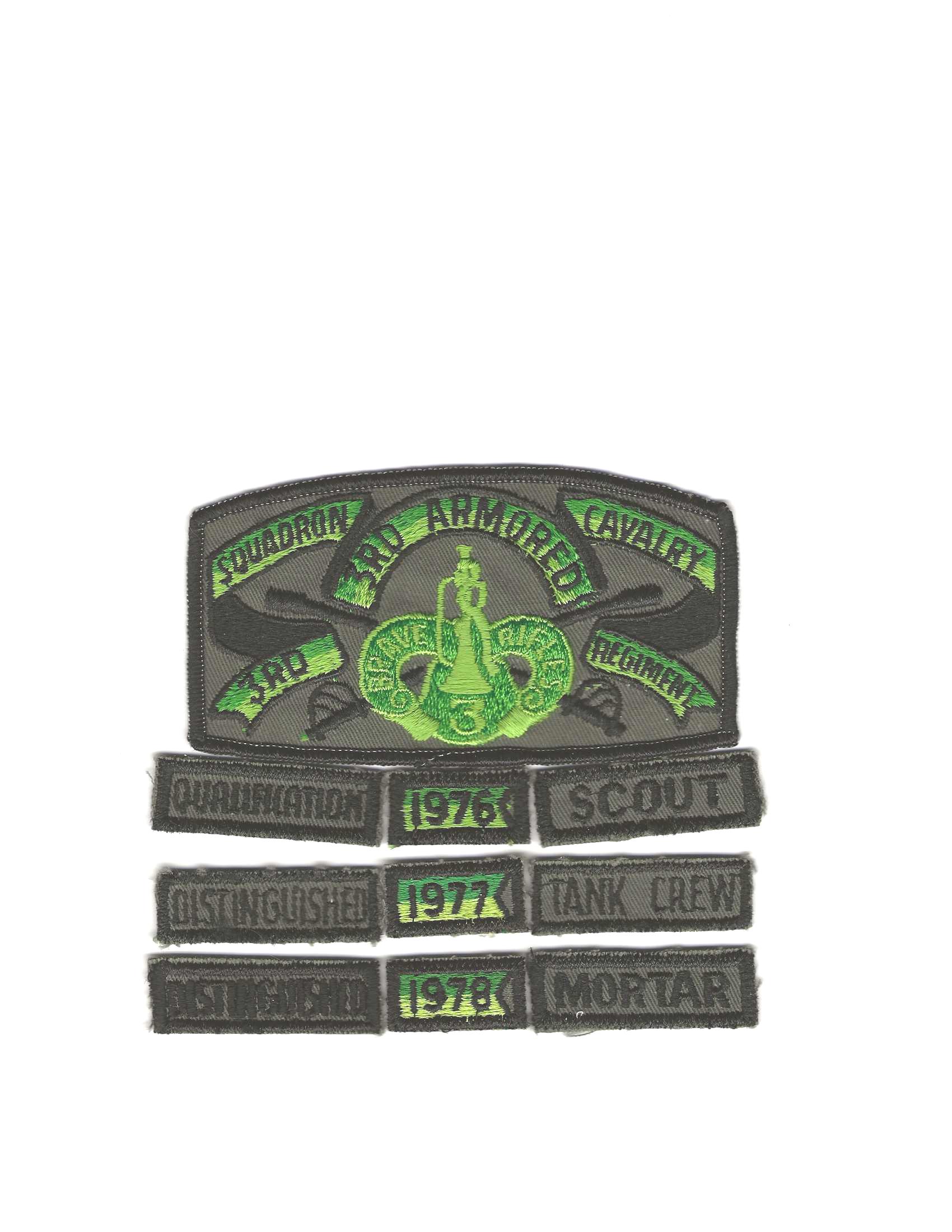
Figure 22
3rd Sqdn, 3rd Armored Cavalry Regiment qualification patch, with assorted tabs. U.S. made, embroidered on twill. The patch has a merrowed edge, while the tabs have a standard edge. ASMIC #3E, 3E1, 3E2, 3E3, 3E4, 3E5, 3E6, 3E7, 3E9.
Other Units & Installations
The 5th Infantry Division(Mech)(-) was reactivated in 1974 at Fort Polk, Louisiana. The Division issued TCQC patches beginning apparently in 1976 and continuing through at least 1983. See, e.g., Figure 23.
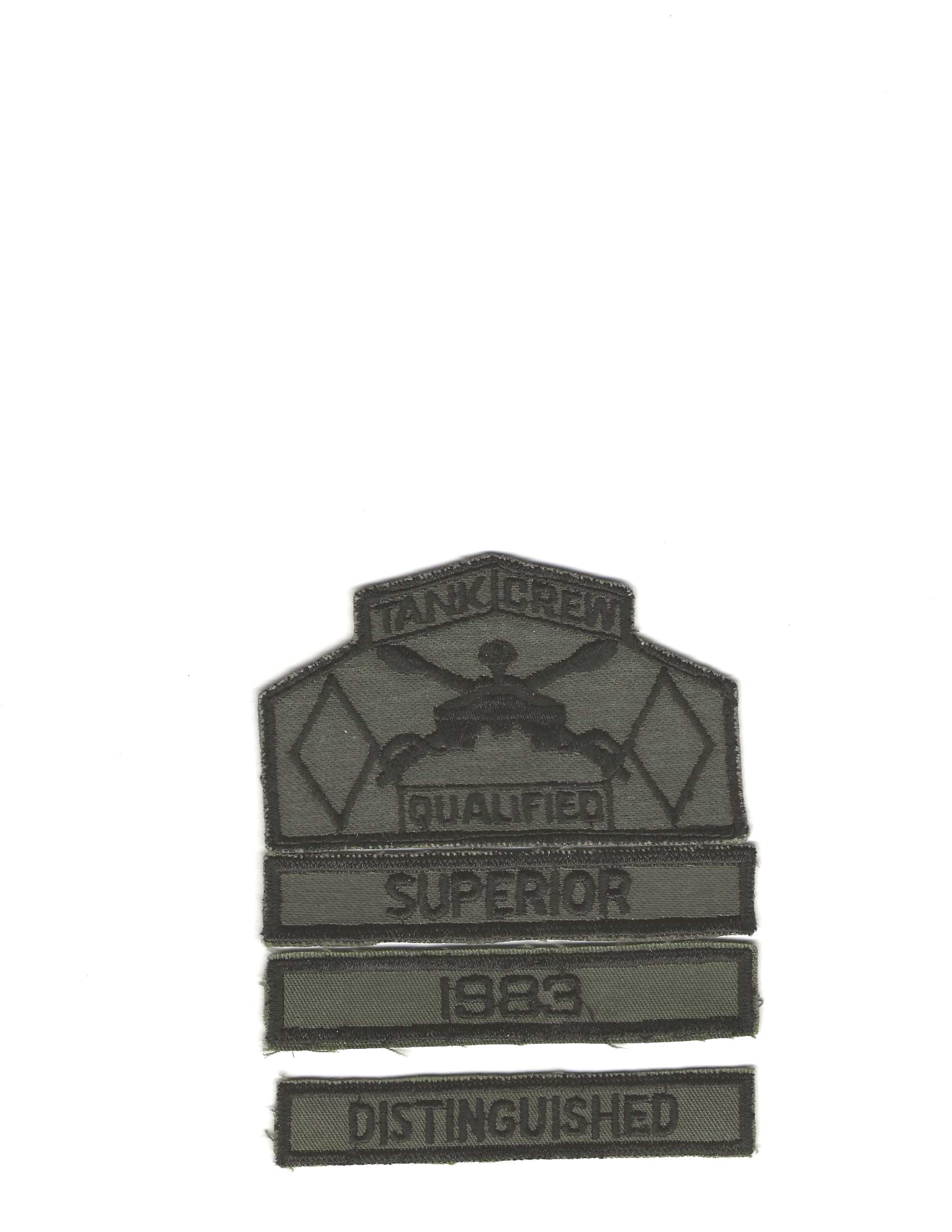
Figure 23
5th Infantry Division(Mech) Qualified TCQC patch (not in ASMIC catalog), with "Superior" (ASMIC #5M2), "Distinguished" (ASMIC #5M1), and "1983" (ASMIC #5M4) tabs. U.S. made, embroidered on twill with a standard edge.
The only other qualification patch that the 5th ID was definitely known to have issued was a mechanized infantry patch, but I have heard the Division also issued patches to scout vehicle and M551 Sheridan crews. As far as I am aware, none of the units assigned to the 5th Infantry Division(Mech)(-) issued their own qualification patches.
*
*
*
The 197th Infantry Brigade was stationed at Fort Benning, Georgia, and supported the Infantry School. Two of the Brigade's units wore qualification patches. The 2nd Bn, 69th Armor wore patches in at least 1974, 1975, and 1978. See, e.g., Figure 24.
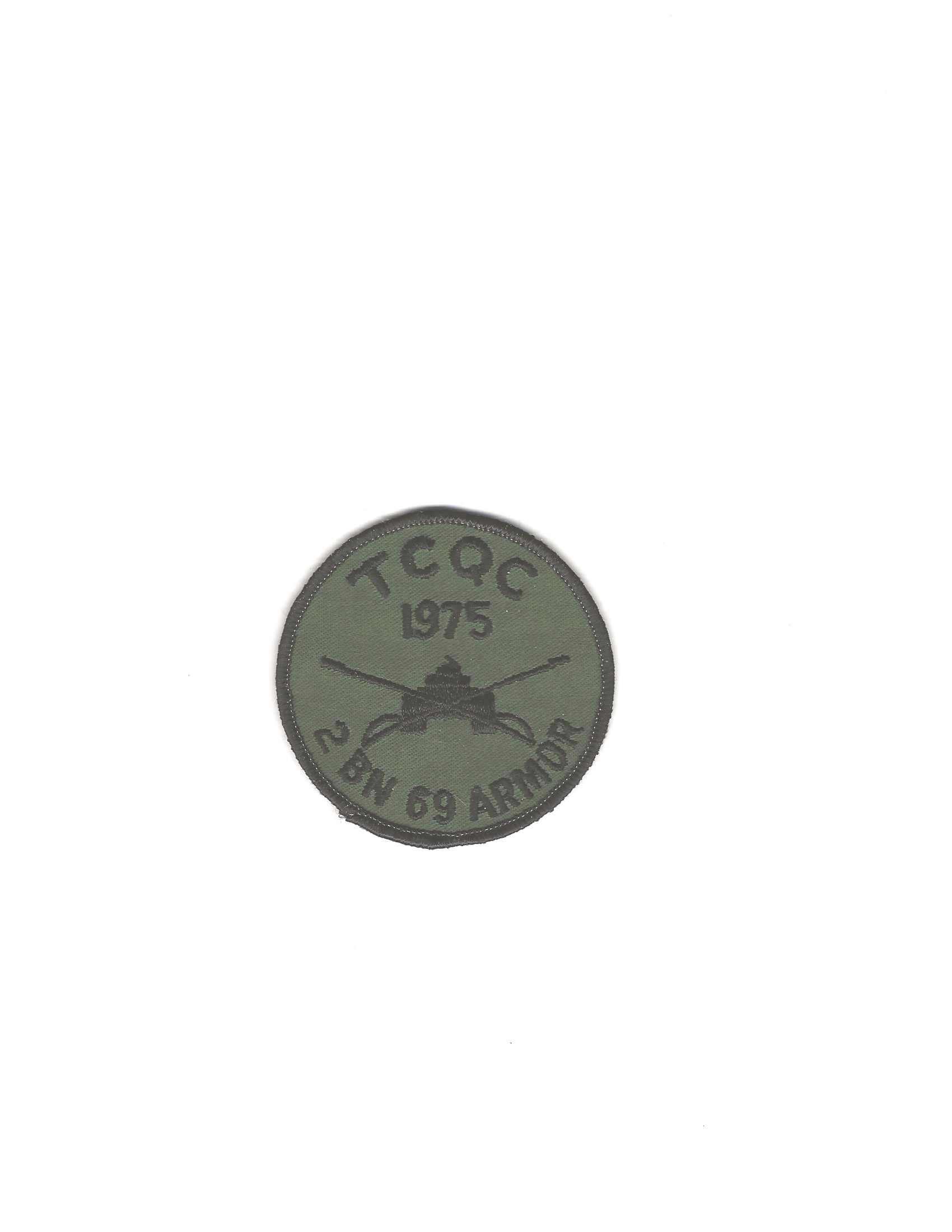
Figure 24
2nd Bn, 69th Armor 1975 TCQC patch (197th Inf Bde). U.S. made, embroidered on twill with a merrowed edge. Not in ASMIC catalog. It is unclear if this patch was issued in a "Distinguished" or "Support" version (or if a "Distinguished" or "Support" tab was issued with this patch).
In addition, there are several other 2-69 Armor patches that lack a year, so this unit probably wore gunnery patches in other years, and this unit was reportedly one of the few that awarded gunnery patches in the 1990s. Troop A, 15th Cavalry also wore gunnery patches at some point. See, e.g., Figure 25.

Figure 25
Troop A, 15th Cavalry qualification patch (197th Inf Bde). U.S. made, embroidered on twill with a merrowed edge. ASMIC #15C. It is unclear which vehicle crews were eligible to wear this patch. It is also unclear if this patch was issued in a "Distinguished" or "Support" version (or if a "Distinguished" or "Support" tab was issued with this patch). Finally, it is unclear when this patch was worn.
*
*
*
The 9th Infantry Division was stationed at Fort Lewis, Washington. It had two Armor branch units that wore qualification patches. The 3rd Sqdn, 5th Cavalry was an air cavalry squadron that had one armored cavalry troop. That troop wore M551 Sheridan TCQC patches without a year on them. In addition, the 2nd Bn, 77th Armor wore qualification patches from at least 1974 to 1978. See, e.g., Figure 26.
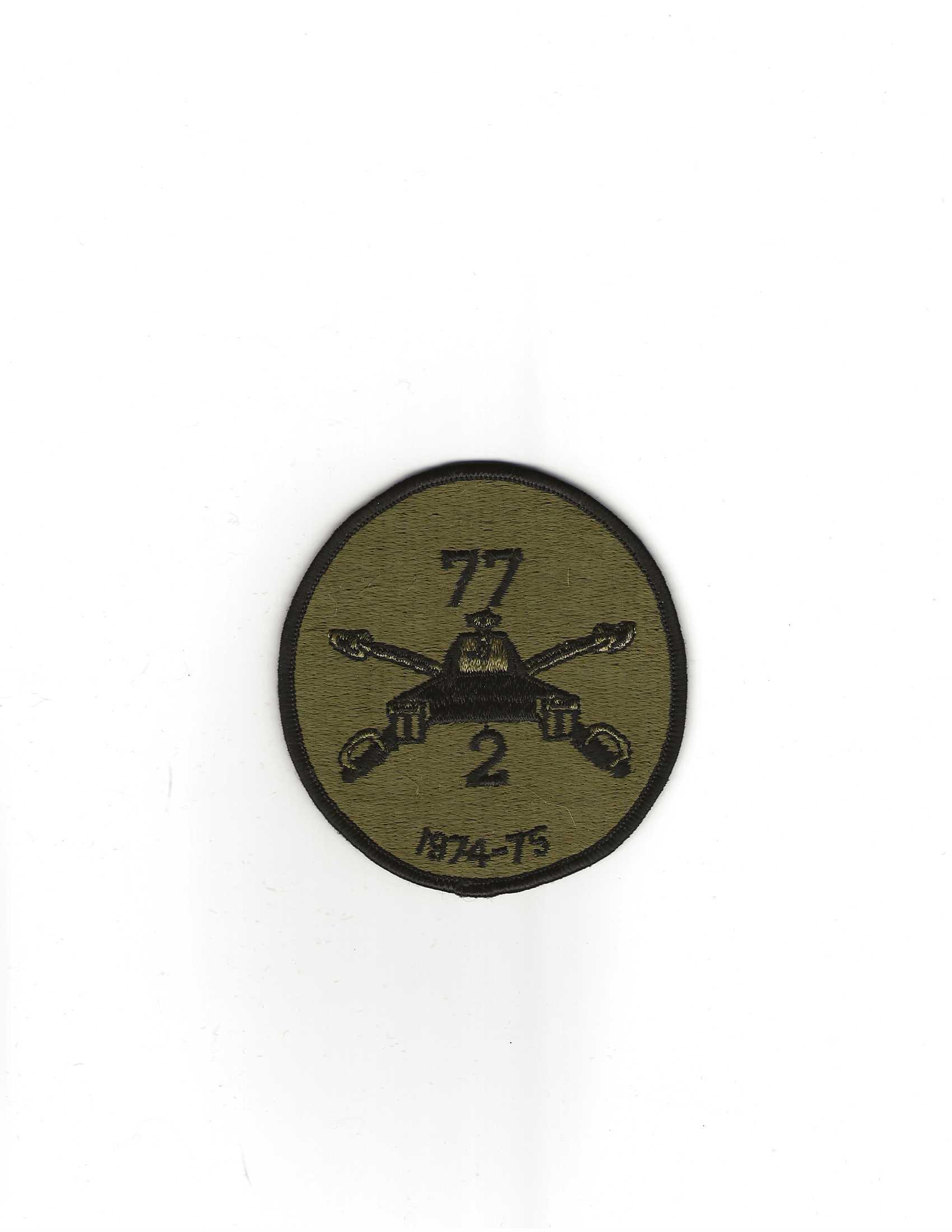
Figure 26
2nd Bn, 77th Armor 1974-75 TCQC patch (9th Inf Div). U.S. made, all embroidered with a merrowed edge. ASMIC #77E. It is unclear if this patch was issued in a "Distinguished" or "Support" version (or if a "Distinguished" or "Support" tab was issued with this patch).
In 1976, 2-77 Armor issued tabs for "High Tank," "High Platoon," and "High Company." See Main Article, Figure 14.
*
*
*
The 82nd Airborne Division was stationed at Fort Bragg, North Carolina. The 4th Bn(Light)(Airborne), 68th Armor was assigned to the Division and was a one-of-a-kind light armor unit that was equipped with M551 "Sheridan" Armored Reconnaissance/Airborne Assault Vehicles in lieu of main battle tanks. The Sheridan was light enough that it could be delivered to an airhead by U.S. Air Force C–130 "Hercules" cargo aircraft using the Low Altitude Parachute Extraction System ("LAPES"). The 4–68 Armor wore TCQC patches in at least 1977 and 1980. See, e.g., Figure 27.
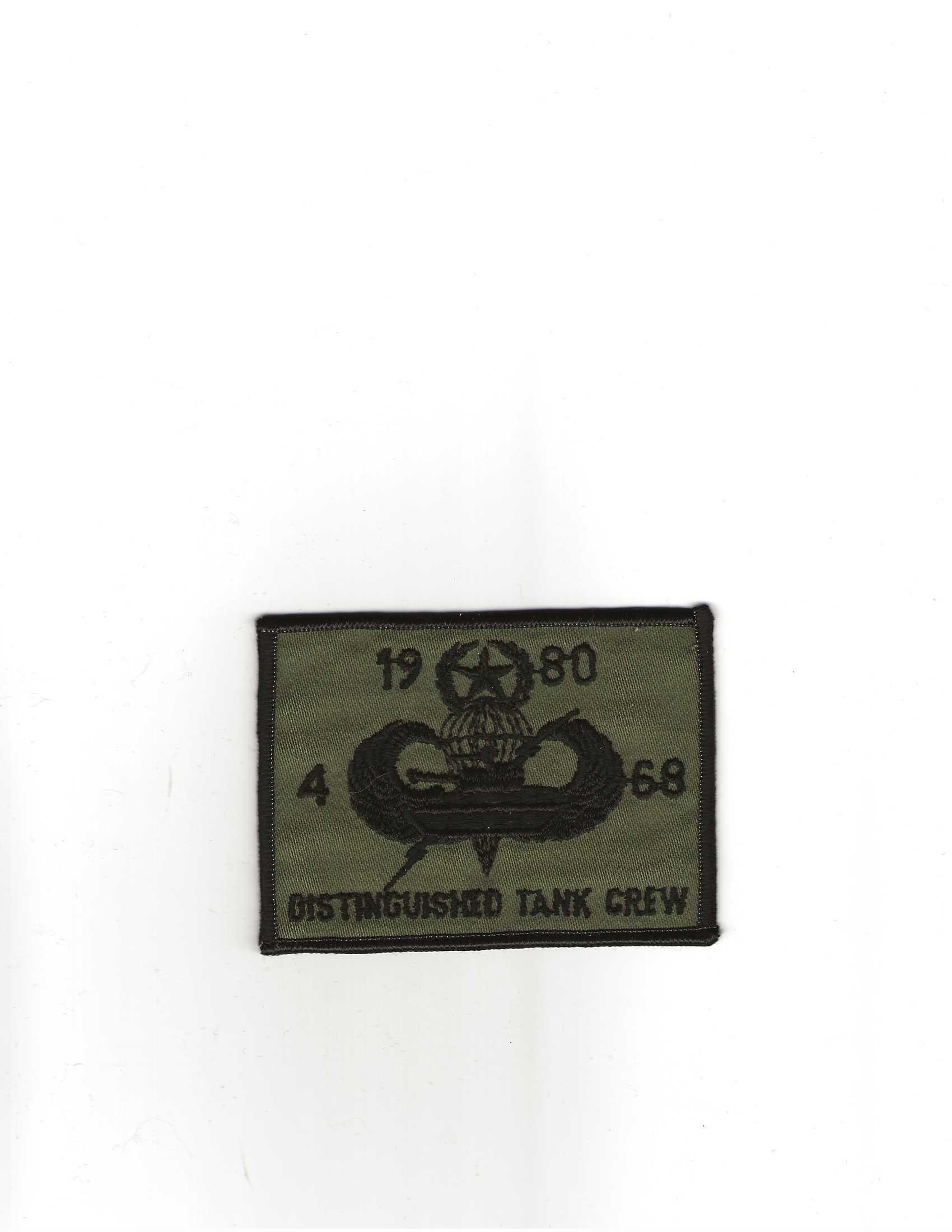
Figure 27
4th Bn(Light)(Airborne), 68th Armor 1980 Distinguished TCQC patch (82nd Abn Div). U.S. made, embroidered on twill with a merrowed edge. Not in ASMIC catalog. This patch was also issued in a "Qualified" version. I do not know if there was a "Support" version of this patch.
There are at least three other TCQC patches for this unit that do not include a year and were presumably worn in other years. The 4–68 Armor was reflagged as the 3rd Bn, 73rd Armor in 1984. There are two different 3–73 Armor TCQC patches that do not include the year on the patch.
The 82nd had one other armor branch unit, the 1st Sqdn(Air), 17th Cavalry. This squadron had some Sheridans at some point, and at times had a ground cavalry troop that was mounted on jeeps. I am not aware of any qualification patches that were worn by this unit.
*
*
*
Fort Stewart, Georgia, was home to the 24th Infantry Division(Mech)(-) from 1979 through the end of the Cold War. This division had three armor battalions and an armored cavalry squadron, but the only qualification patch that I am aware of was issued by the 2nd Bn, 70th Armor. See Figure 28.
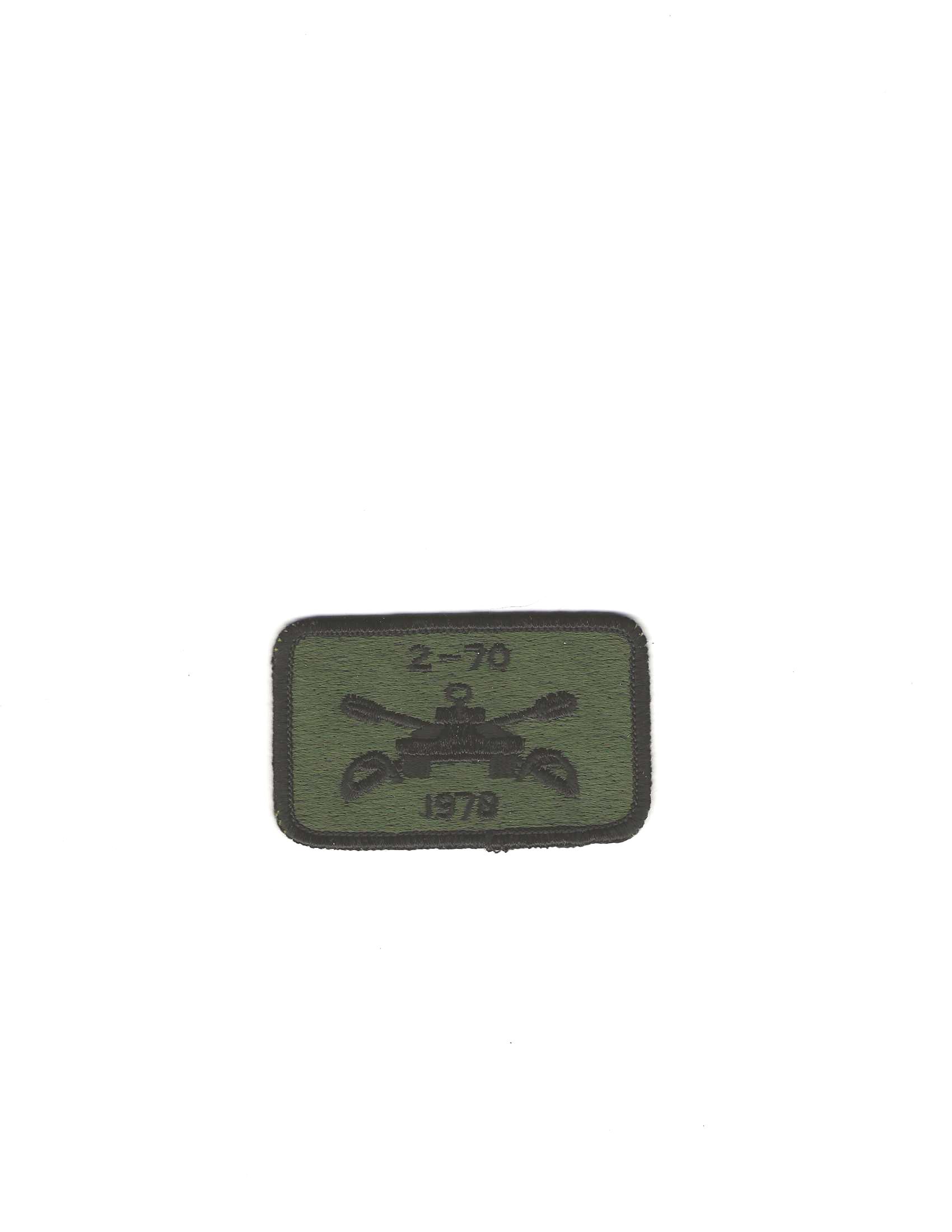
Figure 28
2nd Bn, 70th Armor 1978 TCQC patch (24th Inf Div(M)(-)). U.S. made, all embroidered with a merrowed edge. Not in ASMIC catalog.
*
*
*
Fort Sill, Oklahoma, was home to the Army's Field Artillery branch and III Corps Artillery. This unit included a mechanized infantry battalion and separate tank company that supported the Field Artillery School. The tank company (Company B, 40th Armor) wore TCQC patches in at least 1978. See Figure 29.

Figure 29
Company B, 40th Armor 1978 Qualified TCQC patch with "Distinguished" tab (III Corps Arty). U.S. made, embroidered on twill with a standard edge. Not in ASMIC catalog.
In addition, the Scout Platoon of the mechanized infantry battalion (4th Bn(M), 31st Infantry) wore a qualification patch in at least 1977 and 1978.
*
*
*
Fort Riley, Kansas, was a major Armor installation from the late 1960s through the end of the Cold War. The 24th Infantry Division(Mech)(-) moved there from Germany in 1968 and was then reflagged as the 1st Infantry Division(Mech)(-) in 1970. Throughout this period there were three or four armor battalions and an armored cavalry squadron(-) stationed at Fort Riley. However, I am not aware of any qualification patches that were worn at Fort Riley.
*
*
*
Fort Irwin, California was home to the National Training Center, which specialized in providing advanced maneuver and gunnery training to armored and mechanized units, beginning in the early 1980s. Initially, the Opposing Force at Fort Irwin (which provided the "enemy" that maneuvered against the units that travelled to Fort Irwin to be trained) included one armor battalion, the 1st Bn, 73rd Armor. However, as of September 1984 the 1–73 Armor had not worn any qualification patches, and I am not aware of any TCQC patches being worn subsequently by this or any other unit at Fort Irwin.
*
*
*
The 101st Airborne Division(Air Assault) was stationed at Fort Campbell, Kentucky. The only Armor branch unit assigned to this division was the 2nd Sqdn, 17th Cavalry, which was an air cavalry squadron. I am not aware of any qualification patches worn at Fort Campbell.
*
*
*
The 7th Infantry Division was stationed at Fort Ord, California, from 1974 to 1993. It had one Armor branch unit, the 2nd Sqdn, 10th Cavalry. It was initially an air cavalry squadron(-) and then later, a reconnaissance squadron that operated wheeled HMMWVs and OH-58D "Kiowa" Observation Helicopters. As far as I am aware, there were no qualification patches worn at Fort Ord.
*
*
*
The 10th Mountain Division(Lt Inf)(-) was stationed at Fort Drum, New York, from 1985 to the present. It had one Armor branch unit, the 3rd Sqdn, 17th Cavalry, which was a reconnaissance squadron equipped with wheeled HMMWVs and OH-58D "Kiowa" Observation Helicopters. As far as I am aware, there were no qualification patches worn at Fort Drum.
*
*
*
Fort Hunter Liggett, California, was the home to the U.S. Army Combat Development Experimentation Command ("CDEC"), during the 1970s through 1990s. As of the early 1980s there was a single tank company stationed there: Company C, 13th Armor. It is unknown if this unit wore any gunnery patches.